#Carl Wilhelm Meyer
Explore tagged Tumblr posts
Note
Hey so I'm a self-taught witch who practices independently and I was hoping to learn a little bit from others as well. Do you have any books/resources/people you recommend looking into?
Hi there!
I'm a self-taught witch as well and I'm still at the beginning of my journey, at the moment I'm yet to finish the big blue book Buckland's Complete Book of Witchcraft of which I'm also sharing the lessons (you can find tose posts in my archive here) so for now I can only really recommend that one, but I'm marking down all the recommendend supplementary redings at the end of every lesson if you wanna check them out!
I'm also reading a very interesting and complete book about tarot called Holistic Tarot which i really recommend, it's a bit expensive maybe but it's totally worth it
Other than that I can write down here the list of recommended reading at the end of the blue book (with extra books other than the ones already listed at the end of every lesson), I can't recommend those personally (even if I did buy some of them but I still have to read them) but I think they're worth a shot if you'd like to know more, I'll add the other two I mentioned above in the list, in any case if you find other books online read carefully all the reviews cause many books are not serious about this topic
Also I'm not sure but I think these books below are all from white people and mainly about white cultures (and most of them are very old), so If you (or anyone else) have some recommendations about other cultures' book about witchcraft or ancient traditions I'd be glad to know more about that too!
As for people and other resources, I follow some witches on Twitter that shares interesting stuff, it would be too long to link all of their profiles so I can give you directly the list of people I follow here
I hope you'll find this helpful~
Color Healng by Mary Anderson
Gods and Goddesses of Ancient Greece by Edward E. Jr Barthell
Crystal Gazing by Theodore Besterman
I-Ching: The Book of Changes by J. Blofeld
Primitive Song by C. M. Bowra
Gerald Gardner: Witch by J. L. Bracelin
The Lost Gods of England by Brian Branston
Development of Religion and Thought is Ancient Egypt by J. H. Breasted
Buckland's Complete Book of Witchcraft / Amazing Secrets of the Psychic World / Color Magick / Gypsy Dream Dictionary / A Pocket Guide to the Supernatural / Practical Candleburning Rituals / Scottish Witchcraft & Magick / The Tree: Complete Book of Saxon Witchcraft / Wicca For Life / The Witch Book: Encyclopedia of Witchcraft, WIcca and Neopaganism / Witchcraft From the Inside by Raymond Buckland
The Holy Book of Women's Mysteries by Zsuzsanna Budapest
Amulets and Talismans by Sir E. A. Wallis Budge
Egyptian Language by Oxford University Press
How to Read the Aura, Practice Psychometry, Telepathy and Clairvoyance by W.E. Butler
Ancient Ways by Dan and Pauline Campanelli
Handbook of Unusual and Unorthodox Healing by J. V. Carney
Handbook of Bach Flower Remedies by Philip M. Chancellor
Color Therapy by Linda Clark
Precious Stones: Their Occult Power and Hidden Significance by W. B. Crow
Lid Off the Cauldron / The Witches Speak Athol by Patricia Crowther
Complete Herbal by Nicholas Culpeper
Earth Power / Living Wicca / Magical Herbalism by Scott Cunningham
Practical Guide to Astral Projection by Melita Dennings and Osborne Phillips
The Silent Path by Michael Eastcott
Patterns of Comparative Religion / Rites and Symbols of Initiation - Birth and Rebirth by Mircea Eliade
The Dream Game by Ann Faraday
What Witches Do / Eight Sabbats For Witches / The Witches' Way by Janet and Stewart Farrar
Magical Rites From the Crystal Well by Ed Fitch
The Golden Bought by Sir James G. Frazer
The Wisdom of Pagan Philosophers by Timothy Freke and Peter Gandy
Totem and Taboo by Sigmund Freud
Witchcraft Today / The Meaning of Witchcraft / High Magic's Aid / A Goddess Arrives by Gerald Gardner
Complete Herbal by Gerard
Stalking the Healthful Herbs by Euell Gibbons
Witchcraft, the Sixth Sense, and Us by Justine Glass
Seasonal Occult Rituals by William Gray
The Encyclopedia of Witches and Witchcraft by Rosemay Ellen Guiley
Ancient Art and Ritual Kessinger by Jane E. Harrison
Palmistry, the Whole View by Judith Hipskind
Myth and Ritual by S. H. Hooke
Witch: A Magickal Journey by Fiona Horne
The Runes and Other Magical Alphabets by Michael Howard
Witchcraft by Penethorne Hughes
Memories Dreams and Reflections by Carl G. Jung
Aradia, Gospel of the Witches of Italy by Charles Godfrey Laland
Witches: Investigating an Ancient Religion / Gogmagog - the Buried Gods by T. C. Lethbridge
Healing For Everyone by E. Loomis and J. Paulson
Numerology by Vincent Lopez
Commond and Uncommond Uses of Herbs of Healthful Living by Richard Lucas
The Herb Book by John Lust
Pagan Parenting by Kristin Madden
Witta: An Irish Pagan Tradition by Edain McCoy
The Principles and Practice of Radiesthesia by Abbè Mermet
The Hearbalist by J. E. Meyer
The Craft by Dorothy Morrison
Green Witchcraft series by Ann Aoumiel Moura
Sexual Occultism by John Mumford
The Family Wicca Book by Ashleen O'Gaea
Reclaim the Power of the Witch by Monte Plaisance
Potter's New Cyclopedia of Botanical Drugs and Preparations by R. C. Potter
How to Make and Use Talismans / The Art of True Healing by Israel Regardie
The Seventh Sense by Kenneth Roberts
High Magic's Aid by Scire
The Book of Charms and Alisman by Sepharial
The Spiral Dance by Starhawk
The Devil in Massachusetts by Marion L. Starkey
Medical Palmistry by Marten Steinbach
Is This Your Day? by George S. Thommen
Magic and Healing by C. J. S. Thompson
Where Witchcraft Lives / An ABC of Witchcraft Past and Present / Witchcraft For Tomorrow by Doreen Valiente
The Rites of Passage by Arnold Van Gennep
Herbal Manual by H. Ward
Holistic Tarot by Benebell Wen
The I-Ching by R. Wilhelm
The Christians As the Romans Saw Them by Robert L. Wilken
The Complete Idiot's Guide to Wicca and Witchcraft by Denise Zimmermann and Katherine A. Gleason
#witch blog#witch#book of witchcraft#witchblr#witchcraft beliefs#philosophy of witchcraft#history of witchcraft#witches#witchcraft#reading recommendations#introduction to witchcraft#witches of tumblr#books about witchcraft#books recommendations#witchcraft resources#medusa's answers
13 notes
·
View notes
Text

Dieses Stillleben von Georg Flegel wirkt irritierend, doch nicht durch den wie beiläufig abgebildeten Apfel — aber Waffeln? Offenbar gab es die also schon im frühen 17. Jahrhundert. Der einzige mir bekannte Waffelforscher, Wilhelm Meyer zu Venne vermutet in seiner Waffelgeschichte Die Welt der Waffel den Ursprung allen waffelartigen Gebäcks sogar in vorchristlicher Zeit und dabei auch noch im Orient.
Das Wort «Waffel» selbst aber dringt um die Zeit der Entstehung dieses Stilllebens erst in den deutschen Sprachschatz ein. Es wird sich also um eine Auftragsarbeit gehandelt haben, bei der Maler Flegel die exotische Köstlichkeit als Statussymbol zu verewigen hatte. Der Apfel bringt etwas Farbigkeit in sein ansonsten streng flämisch monoton gehaltenes Bild; vermittels seines garantierten Wiedererkennungseffektes dient er, als Frucht an sich, zudem noch der Verortung des futuristischen Motivs in einer sattsam bekannten Realität. Man könnte sich schon fragen, was die Menschen hier in unseren Breiten eigentlich zu sich genommen haben, bevor der Apfel und im Grunde auch die Waffel aus dem Orient zu ihnen gebracht worden waren.
Übrigens ist Waffelforscher Meyer zu Venne von Beruf selbst Waffelfabrikant. Und zwar in zweiter Generation mit «Waffel Meyer», angeblich sogar das größte Waffelunternehmen der Welt.
Die wichtigen Pomologen, wie Richard Cox, Carl Julius Fintelmann, Johann Knoop und Caspar Tobias Zollikofer waren auch allesamt Männer der Praxis.
5 notes
·
View notes
Photo

32 INCREDIBLY WEIRD DEATHS
1. Brazilian Joao Maria de Souza was killed in 2013 when a cow fell through his roof onto him as he slept.
2. Clement Vallandigham, a 19th century US lawyer, accidentally shot himself dead while defending a murder suspect – because he was trying to demonstrate that a supposed victim could have accidentally shot himself dead. (It worked, because his client was acquitted.)
3. Canadian lawyer Garry Hoy died while trying to prove that the glass in the windows of a 24th floor office was unbreakable, by throwing himself against it. It didn’t break – but it did pop out of its frame and he plunged to his death.
4. In 2007 the deputy mayor of Delhi, Surinder Singh Bajwa, died falling off a balcony while trying to fend off a troupe of attacking monkeys.
5. Monica Meyer, the mayor of Betterton, Maryland, died while checking her town’s sewage tanks – she fell in and drowned in 15 feet of human waste.
6. Sigurd the Mighty, a ninth-century Norse earl of Orkney, was killed by an enemy he had beheaded several hours earlier. He’d tied the man’s head to his horse’s saddle, but while riding home one of its protruding teeth grazed his leg. He died from the infection.
7. The owner of the company that makes Segways died in 2010 after accidentally driving his Segway off a cliff.
8. Robert Williams, a Ford assembly line worker, is the first human in history to have been killed by a robot. He was hit by a robot arm in 1979.
9. In 1923, jockey Frank Hayes won a race at Belmont Park in New York despite being dead — he suffered a heart attack mid-race, but his body stayed in the saddle until his horse crossed the line for a 20–1 outsider victory.
10. US congressman Michael F. Farley died in 1921 as a result of shaving – because his shaving brush was infected with anthrax.
11. Several people danced themselves to death during the month-long Dance Fever of 1518 in Strasbourg, during which hundreds of people danced for about a month for no clear reason.
12. Paul G. Thomas, the owner of a wool mill, fell into one of his machines in 1987 and died after being wrapped in 800 yards of wool.
13. Edward Harrison was playing golf in Washington state in 1951 when his driver snapped, and the shaft lodged in his groin. He staggered about 100 yards before bleeding to death.
14. In 1900, American physician Jesse William Lazear tried to prove that Yellow Fever was transmitted by mosquitoes by letting infected mosquitoes bite him. He then died of the disease. Proving himself right.
15. Russian physician Alexander Bogdanov performed pioneering blood transfusions on himself, believing they would give him long life. They actually killed him after he suffered an adverse reaction.
16. Austrian tailor Franz Reichelt thought he’d invented a device that could make men fly. He tested this by jumping off the Eiffel Tower wearing it. It didn’t work. He died.
17. In 1567, the man said to have the longest beard in the world died after he tripped over his beardrunning away from a fire.
18. The Greek philosopher Chrysippus of Soli is said to have died of laughter after watching a donkey trying to eat his figs.
19. British actor Gareth Jones died of a heart attack while performing in a live televised play in 1958 – in which his character was scripted to have a heart attack. The rest of the cast improvised around his death and finished the play.
20. Mary Ward was a pioneering Irish female scientist who is sadly better known as the first person in history to ever be killed in a car accident – while driving with her family in their experimental “road locomotive steam engine”.
21. And the first pedestrian ever killed by a car was Bridget Driscoll of Croydon, London, in 1896.
22. Carl Wilhelm Scheele was a brilliant Swedish chemist who had an unwise habit of tasting all the chemicals he discovered. He died in 1786 as a result of his exposure to lead, hydrofluoric acid, arsenic and various other poisons.
23. Engineer Horace Lawson Hunley pioneered submarine design in the American Civil War – although most of them sank. He died when his final model, named after himself, sank while he was in command of it.
24. General John Sedgwick was killed by a sniper in the American Civil War shortly after uttering the words “They couldn’t hit an elephant at this distance.” (Contrary to popular belief, though, they weren’t his last words. They were his second-last. His last words were agreeing that dodging was in fact a good idea.)
25. Health fanatic Basil Brown managed to kill himself by drinking a gallon of carrot juice a day, in the belief it would make him healthy.
26. In 1992, Greg Austin Gingrich died in the Grand Canyon after jokingly pretending to fall to his death, then losing his footing and actually falling to his death.
27. Queen Sunanda Kumariratana of Siam (now Thailand) drowned in 1880 in full view of many of her subjects – because they were forbidden to touch her, so couldn’t rescue her.
28. The first people ever killed in an air accident were hot air balloon pioneers Jean-François Pilâtre de Rozier and Pierre Romain, in 1785.
29. And the first person ever killed in a powered aeroplane crash was Lieutenant Thomas Selfridge in 1908, in a plane piloted by Orville Wright.
30. An Irish woman died in 2008 after voluntarily having sex with a dog. The exact cause of death is unclear, although it was speculated that an allergic reaction to dogs might have been the cause.
31. Twenty-one people died in the Boston Molasses Disaster of 1919, when a massive tank of molasses burst on a warm day, sending a 25ft high wave of sweetener through the city at 35mph.
32. And eight people died in the London Beer Flood of 1814, when a giant vat at a brewery burst, sending over 3,500 barrels of beer pouring though the nearby streets.
37 notes
·
View notes
Text
Looking UP: Street Lamps from Bucharest, Romania #travel #pictures
Looking UP: Street Lamps from Bucharest, Romania. This past holiday I chose to look up, towards the sun, the sky and the buildings' roofs. I discovered surprising sights. With intricate designs, they border past and present. Which side will you choose?
This past holiday I chose to look up, towards the sun, the sky and the buildings’ roofs. I discovered some surprising sights that put a smile on my face and sparked my writer’s brain (or so I liked to imagine).
An old-style street light in Bucharest, on Lipscani Street, guarding the border between new and old – image by @PatFurstenberg
Also bordering past and present – which side would you…
View On WordPress
#Alexandru Ipsilanti#Bucharest#Calea Victoriei#Carl Wilhelm Meyer#first city in the world#gas lighting#Gheorghe Bibescu#Grand Fountaineer#Hanul lui Manuc#history#holiday#lamp posts#lamp standard#lamplighter craft#lamppost#light pole#lightstandard#Lipscani#Muzeul Satului#night#Parcul Cismigiu#street#street lamp#street lights#Travel#Village Museum#what to see
0 notes
Text
July 03 in Music History
1550 Birth of composer Jakob Handl.
1814 Birth of composer Janis Cimze.
1816 FP of Carafa's "Gabriella di Vergy" Naples.
1819 Birth of composer Louis Theodore Gouvy.
1836 Death of English soprano Cecilia Davies.
1842 Death of Italian soprano Matilde Palazzesi.
1846 Birth of Russian composer Achilles Alferaky in Ukraine. 1848 Birth of American music publisher Theodore Presser of Philadelphia. Also published The Etude magazine.
1850 Birth of composer Alfredo Kiel.
1852 Birth of Hungarian-American pianist Rafael Joseffy. 1854 Birth of Czech composer and conductor Leoš Janáček in Hukvaldy. 1860 Birth of Scottish composer William Wallace.
1860 Birth of bass Wilhelm Hesch in Labsky Tynec.
1861 Birth of German tenor Oskar Feuge in Reudnita.
1862 Birth of composer Friedrich Ernst Koch.
1871 Birth of Basque composer Vicente Arregui Garay.
1873 Death of Italian tenor Josef Poniatowski.
1874 Death of German pianist and composer Franz Bendel in Berlin.
1879 Birth of French composer Philippe Gaubert.
1880 Birth of composer Carl Schuricht.
1881 Death of Italian baritone Achille De Bassini.
1885 Birth of Swedish baritone Carl Richter in Stockholm.
1890 Birth of Austrian bass Jossef Manowarda.
1892 Birth of composer Wilhelm Rettich.
1894 Birth of Italian soprano Bianca Scacciati in Faenza.
1895 Birth of Russian bass Mark Reizen in Moscow.
1895 Birth of composer Oles' Semyonovich Chishko
1899 Birth of composer Klimenty Arkad'yevich Korchmaryov.
1899 Birth of composer Otto Reinhold.
1901 Birth of American composer Ruth Crawford Seeger.
1907 Birth of German composer Romeo Maximilian Eugene Ludwig Gutsche.
1907 Birth of Italian soprano Cesarini Valobra.
1912 Birth of German soprano Elinor Junker-Giesen in Berlin.
1920 Birth of American composer John Lessard.
1922 Birth of Scottish bass David Ward in Dumbarton, Scotland.
1923 Birth of American composer Jean Eichelberger Ivey.
1926 Birth of American composer Meyer Kupperman. 1930 Birth of German conductor Carlos Kleiber in Berlin.
1932 Birth of Italian tenor Tito del Bianco.
1933 Birth of Chilean mezzo-soprano Laura Didier in Santiago Chile.
1937 Birth of American filmscore composer David Shire.
1939 Birth of German mezzo-soprano Brigitte Fassbaender in Berlin.
1940 Birth of Irish mezzo-soprano Bernadette Tattan Greevy in Dublin.
1942 Birth of American baritone Thomas Jamerson in New Orleans.
1944 FP of Robert Wright & George Forest's musical The Song of Norway, with music of Norwegian composer Edward Grieg, in San Francisco.
1948 Birth of composer Peter Ruzicka.
1959 Birth of American composer Lawrence Dillon.
1957 Birth of German soprano Gabriele Maria Rounge in Hanover.
1960 Birth of soprano Susanna Anselmi.
1961 Death of soprano Edith De Lys.
1964 FP of Robert Ward's opera, The Lady from Colorado in Center City, CO.
1966 Death of American composer Joseph Deems Taylor, at age 80, in NYC.
1967 FP of Havergal Brian's Symphony No. 4 Das Siegeslied [1929], in London.
1976 FP of Alan Hovhaness' Violin Concerto Ode to Freedom Yehudi Menuhin and André Kostelanetz conducting, at Wolf Trap in Vienna, VA.
1979 Death of French composer Louis Durey in St. Tropez, France.
1981 Death of tenor John Brooks McCormack.
1998 Death of English romantic composer George Lloyd in London. 2004 FP of Dr. Phillip Smith's War Between the States - Music of the American Civil War and Les Marsden's 'American' Symphony on New and Old Tunes at Yosemite National Park.
2000 Death of American baritone Walter Cassel.
2006 Death of American mezzo-soprano Lorraine Hunt Lieberson.
9 notes
·
View notes
Text
Meyer/Meyer family history A CONVERSATION WITH AUNT ESTHER IDA MAE (MEYER) SCHENCK - 1993
By sisters
Linda L. Borgwardt
& Carol Holmbeck
2017
A conversation with our Aunt Esther, my Mother

Back 24 years ago, my sister Carol and I took a day-trip to Reedsburg with her Aunt Esther … my mother, Esther Ida Mae (Meyer) Schenck. Our actual destination was the Green Wood Cemetery, where my mother’s parents were laid to rest. Carol went with us to see the cemetery, but more importantly, to learn more about our Meyer history.
On our trek, Carol spent almost the entire trip questioning my Mother, and recording her answers. We learned a lot about our Meyer roots that day…. Thanks to Carol’s efforts for recording … and thanks to Brenda, Carol’s daughter, who back in 1993, tediously typed up both the questions and answers … thus, we have Aunt Esther’s memories for prosperity.
When I found this file in my computer 24 years later, I instantly knew this needed to be shared. I wanted to share it, so that others who were interested to learning more about our Meyer roots can.
Before I get started with the story, it’s important to explain how my Mother (Esther) is my Sister Carol’s Aunt Esther … well, Aunt Esther is my aunt, too. … If you don’t know our family history, you may ask, “How can that be?”
You see, Carol’s and my biological father was Arthur Henry Meyer. He was Esther’s second brother. He, and his first wife Vera, had seven children in ten years from 1937 to 1948: Dale, Roy, Ralph, Nina, Carol, Johnny and me … Linda. Because of a bad economy after the end of WWII, like so many others, Art had trouble finding work. And … because of Vera’s mental illness, which unfortunately was schizophrenia … due to no fault of her own, Art and Vera were unable to care for us.
Back in those days, adoption was pretty common for families who experienced a death in the family, financial difficulties, divorce, or any other unfortunate event. When these events occurred, there may have been very few options. And, the family had to make the decision to be split up, and the children were put up for adoption. That is why we seven were put up for adoption. There were no fall backs.
In the late 1940s, there weren’t many social programs to help kids out when families broke up, like there is today. Usually, if the kids weren’t taken in by family members, most of the time the kids would go to orphanages, and hope and pray … and wait … to be adopted. …. You might say that the orphanages were the social programs of that day.
Aunt Esther and Uncle Bill Schenck, along with both Art and Vera’s other brothers and sisters, tried to help care for us. Many relatives brought food and clothing. Others took us to their homes for a day, or two, or more. However, things were going south for our family of seven kids.
Consequently, all we seven kids were put up for adoption. Unfortunately, we were separated and placed into four different families. Three of the families did not have children. Dale and Nina went to the Beckmans; Roy and Carol to the Kiekhafer; and Ralph and Johnny to the Bovees. … As for me, I was adopted by family … our Aunt Esther (Meyer) and Uncle Bill Schenck, and I gained another sister, as they had a daughter of their own.
So, what does this mean? First, Aunt Esther and Uncle Bill were my aunt and uncle, and then when I was adopted, they became my mom and dad. So, now you know how Carol and I are sisters. … Oh wait … would that make us cousins, too?... Shhhhheeeewww! … I am glad I have straightened this out in my mind. Otherwise, I would be lost. Well, if I am lost, my kids will put me in the “home.” So, I guess I will never be totally lost. (Chuckle)
The Purpose of our Trip was two-fold.
On this particular trip, again, the main purpose was to take Mother up to the Greenwood Cemetery by Reedsburg. Her dad, mother and youngest brother Frank (she always called him Frankie.) were laid to rest there, and she wanted to put flowers on their graves. Before my dad passed, every Memorial Day he and my mother would make the trip up.
The cemetery is located on the north edge of Reedsburg along Hwy. K (Myrtle St.) It is and about a 1½ hour drive from Afton, WI, where they lived. After leaving the cemetery, mother and dad would visit a few of Bill’s nieces and nephews, who lived in and around Reedsburg and Baraboo. Since my dad passed at the end of 1989, I became the person to take Mother up.
Mother and I would usually drive up there every year, or two. Back in 1993, my sister Carol was BIG into genealogy (well … still is), and was absorbed in digging deeper into our Meyer-Meyer family. This including Mother’s parents … our grandparents … Henry (Hank) Meyer and Emma (Meyer) Meyer. Carol is one of our family genealogists. Nina along with her daughter Tammy have also dug into the Meyer genealogy.
You see, prior to our trip, Carol had paid a visit to her mother-in-law Florence (Steininger) Holmbeck. She asked lots of questions about Florence’s Steininger-Holmbeck histories. Carol recorded her answers, and then asked her daughter Brenda if she would type up their conversation. Florence’s kids and grand kids were, and still are, extremely grateful. Therefore, we thought this would be a wonderful opportunity to capture Mother’s memories.
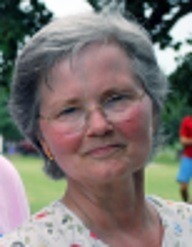
Carol was so excited to go with us. She brought along her handy-dandy tape recorder … we didn’t have palm cams then. She recorded all her questions and all of Mother’s answers. From the time I pulled out of Mother’s driveway, she started recording.
Can you imagine a person bombarding an 80 some-year-old lady with 126 questions? Well, Carol did. No … she wasn’t interrogating her (chuckle), but we sure had fun during the entire drive. Many of Mother’s answers, we pretty much knew the answers to. However, there were many questions that shed a new light on parts of the Meyer-Meyer history that Carol and I were not aware of.
It was so wonderful to watch Mother’s face light up as she strolled down memory lane back to the good ole’ days. Her face was glowing like I had never seen before. And … it goes without saying, Carol and I enjoyed the entire trip … every minute of it. Even after 23 years, it is still just as much fun for us to read Mother’s words … and … remember our special trip together with her.
Also, just for reference…
Q – Questions asked by Carol
A – Answers given by Aunt Esther
L – Questions by Linda
Note -- Updates, corrections, add information to, or help clarify Mother’s story.
KEEPING TRACK OF THE MEYER NAMES
Now, keeping track of the “who’s who” of the Meyer-Meyer family ... well … was pretty confusing to me. Actually, it was probably the hardest part of all. … I have always been great with numbers, but names go out the window pretty quickly. For some reason committing those the Meyer-Meyer family names to memory have always been difficult, except Henry and Emma. I am not sure if it was the first names, middle names … or just the last names. (Chuckle) Therefore, when I tried working on our genealogy, I would have to call Nina or Carol. I felt like a dumb-nut almost every time. So, just so that we … especially me … can keep them straight, I am listing our ancestors. … As far as I know, the following list is as far as our genealogy has taken us backwards. … Oh, by the way, there will be a quiz at the end! Just kidding.
GENEALOGY OF EMMA (Meyer) & HENRY MEYER
Esther’s parents
Emma Dorothea Meyer (1878 - 1930)
Henry Wilhelm Meyer (1881 - 1961)
Emma’s parents
Johann Peter Christoph Meyer (1838 - 1890)
Dorothea Magdelena Heitman Meyer (1844 - 1911)
Henry’s parents
George Christopher Meyer (1830 - 1910)
Catharina Margretha Behn Meyer (1845 - 1922)
Catharina’s parents
Heinrich Henry Johann Behn (1816 – 1899)
Catharina Dorathea Burmeister (1816 – 1896)
Our Day Trip to Reedsburg

Emma Dorothea Meyer (1878 - 1930)
QUESTIONS
Q 1. Tell us about your mom coming over on the ship.
A. She came over on the ship with her family.
Q 2. Sisters and brothers?
A. I think two families came over together.
Q 3. Do you have anything that shows when they came? Do you know where they landed?
A. No, they never talked about those things.
Q 4. Where did they come from ... Germany?
A. Yes, Germany.
Note: Her obituary reads, “Mrs. Meyer was born in Hanover, Germany, May 6, 1878 and when three years old her parents came to America and her early youth was spent on a farm near Loganville.”
Q 5. Did they ever mention any towns over there where they lived?
A. My grandmother’s obituary said Hanover, Germany.
Q 6. Did she (Emma) have a lot of brothers or sisters?
A. No, she only had one sister. She had a brother who died when he was young.
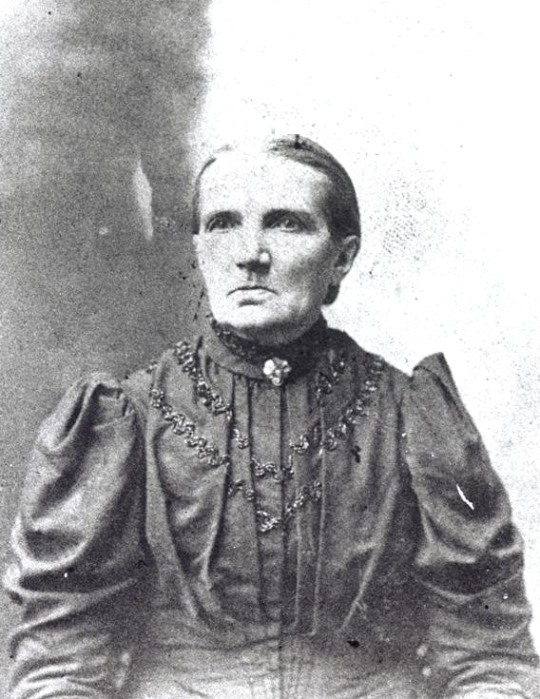
Dorothea Magdelena Heitman Meyer
Obituary

Words from the obituary above.
Mrs. Magdalena Meyer, whose maiden name was Heitmann was born November 16th 1844 at Oberhalverbec Hanover, and was married to Peter Meyer in 1872. They came to Reedsburg in 1881. Later they moved to a place south of Loganville where her husband died in 1891. For nine years she stayed with her sister Mrs. John Westermann. Her last years were spent with her daughter Mrs. H. Meyer where she died Jan. 1st. She was subject to spasms ever since she was 21 years old in one of which she died while the family was away attending morning services at church, her hymn book was lying by her side. The deceased was aged 66 years 1 month 16 days. She leaves behind 2 daughters Mrs. H. Meyer and Mrs. Carl Bajen and one sister Mrs. Catherine Westermann.
Note: Find-a-Grave
... indicates that Emma had three siblings, which the family never talked about it. Listed below are Emma and her brother and sisters in birth order.
Three sisters & one brother in Emma’s family
Catherine Wilhelmine Dorothea Meyer (1875 - 1881)
Note: Catherine lived to be about 6 years of age, which is, coincidentally, the same year the family would have come over to America.
Emma Dorothea (Meyer) Meyer (1878 –1930)
Note: Emma was three when her parents left Germany for America.
Ida Mae (Meyer) Blotkamp (1881 - 1963)
Note: Great Aunt Ida was the only surviving sibling of Emma’s.
Karl Johannes Meyer (1885 - 1886)
Note: Karl must have been born in Wisconsin; but only lived a year, or so, if that.
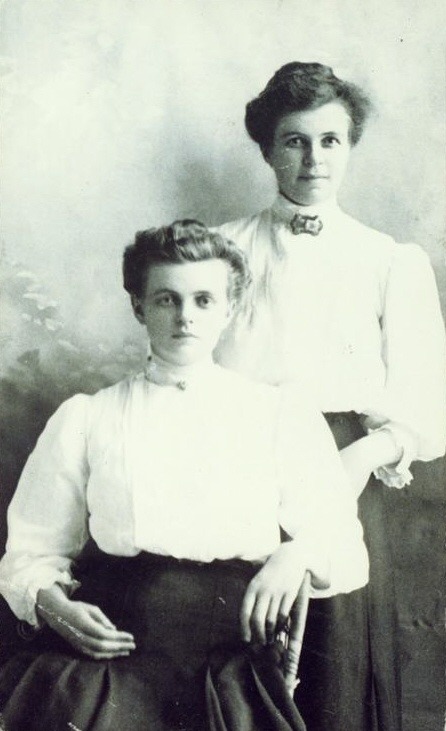
Ida Mae sitting and Emma standing
Q 7. What was your mother’s maiden name?
A. Emma Meyer
Q 8. What was her maiden name?
A. Her maiden name was Meyer, and my dad was also named Meyer.
Q 9. But, they weren’t related, right?
A. No
Q 10. Where did your dad (Henry) come from.
A. He lived in Wisconsin. I think he was born around Reedsburg, or somewhere up there.
Note: His parents came over on the boat in 1867. Their first child, William (Wilhelm) Henry Meyer while on the boat.

Henry and Emma Meyer - 1902
Meyer Reunions of Old in Reedsburg (Dates?)
Six children of
George Christopher & Catharina (Behn) Meyer
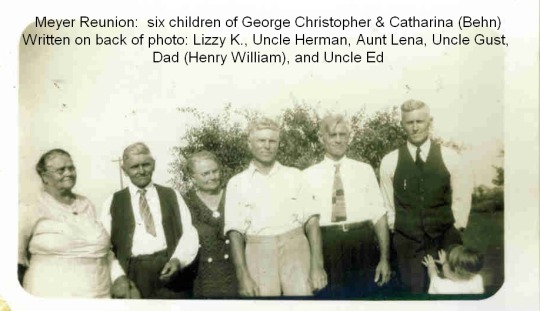
Elizabeth Meyer (1871 - 1961)
Herman Meyer (1874 - 1961)
Lena Teresa Meyer Riley (1876 - 1952)
August Henry Meyer (1879 - 1960)
Henry Wilhelm Meyer (1881 - 1961)
Edward Heinrich August Meyer (1883 -1970)
Two sons not pictured: The oldest son was William Henry Meyer (1867 – 1867). When George Christopher and Catharina came over on the boat, their first born child died, and he may been buried at sea. I thought I read it somewhere, but I cannot confirm that fact about being buried at sea. Also not pictured, their second son, Fredrich John Meyer (1868 – 1948). According to records, he moved to Nebraska. http://www.werelate.org/wiki/Person:Catharina_Behn_%281%29Family tree.
… Two of these reunion photos were my mother’s, and I received one of them from a cousin in Sauk City. Dah! … I can’t believe I didn’t mark them correctly. Now, I have no idea when they were taken. It could be at any wedding, like Esther (Meyer) and Bill Schenck in 1928, or possibly taken in 1930 after the death of Emma’s, Henry’s wife. … Or, for any other large family gathering.
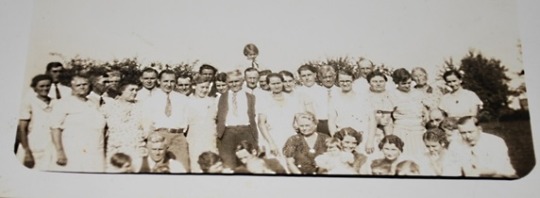
Here are the people I can name in this large group: Aunt Lizzy (Elizabeth) is the second person from the left standing in front. The only person that I could identify as Uncle Gust might be the fifth person from the left standing in the back. The ninth person from the left is most likely my dad, Bill Schenck. Three heads to the right is probably my mother, Esther (Meyer) Schenck. Uncle Hermon is the one in front wearing the unbuttoned vest. Henry, is the seventh person from the right standing up. Uncle Ed is down in front on the left side wearing a buttoned vest. Aunt Lena is sitting down front in the dark top with a shining brooch. … If this photo was taken in 1935, the year Frank died at age, the little girl way up on top could be Bill & Esther’s living twin daughter Dolores. She would be about that age. It sure looks like her. Actually, she looks like the spitting image of Doreen, Dolores’ daughter
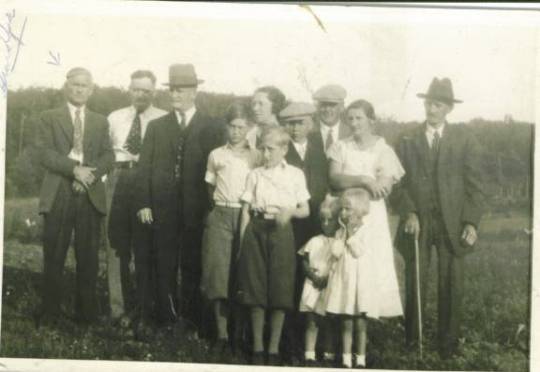
My mother wrote on the back that this was taken in 1928. She was married in 1928. Her dad, Henry, is on the left ... plus ... the others were 6 siblings, but she couldn’t remember who was who.
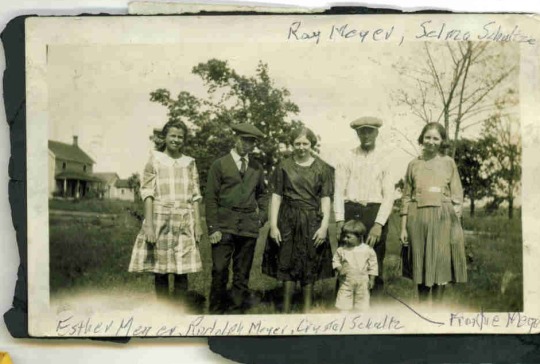
From left to right: Esther Meyer, Rudolph, Crystal Schultz, Raymond Meyer, Selma Shultz and little “Frankie” Meyer… per Esther’s writing on the back of the photo
Q 11. What were his (Henry) parents’ names?
A. His dad’s name was George, and his mom’s was Margarette, something like that.
Note: George Christopher Meyer and Catharina Margareta Behn
Q 12. What were your mother’s parents’ names?
A. Her dad died when she was a girl.
Note: Johann Peter Christoph Meyer and Dorothea Magdelena Heitman
Q 13. Do you remember their names...?
A. I have them at home. His granddaughter has a tree. She went back on the Meyer’s side quite a ways.
Q 14. How many kids were in your family? I know you, Art and Uncle Ervin.
A. There were five of us.
Q 15. Who were the other two?
A. Frankie died; he drowned. He was 15 years old. And, Ray … he is the oldest. He is going to be 90 years old next February (in 1994).
ESTHER AND HER FOUR BROTHERS
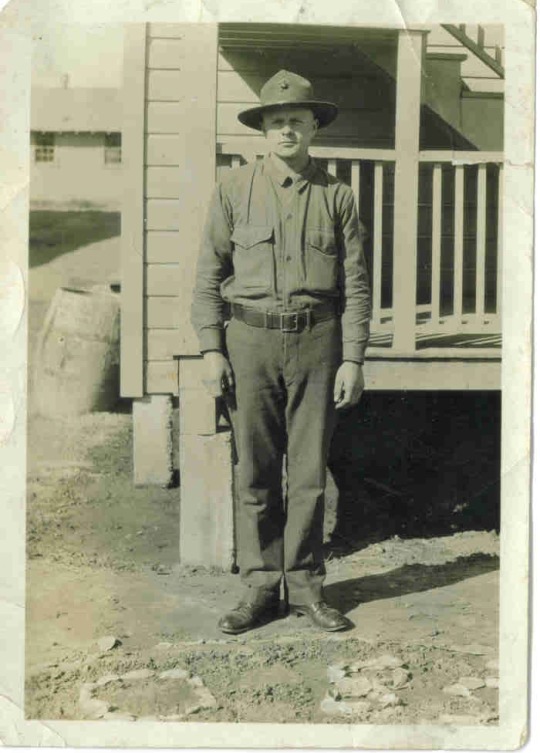
PRIVATE RAYMOND HERMAN MEYER
(1903- 2004) - In his Marine uniform

ESTHER IDA MAE (MEYER) SCHENCK (1909 – 2004) - Age 16
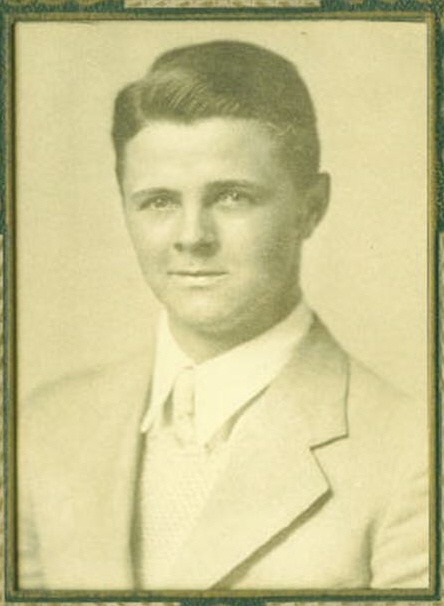
ARTHUR HENRY MEYER (1913 - 1964)
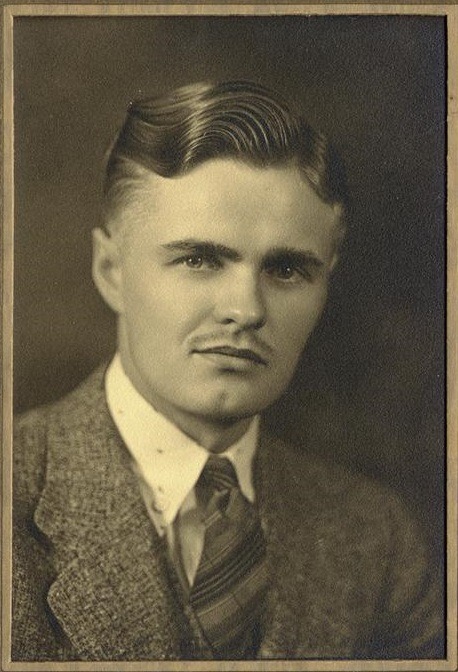
ERVIN AUGUST MEYER (1914 – 2001)
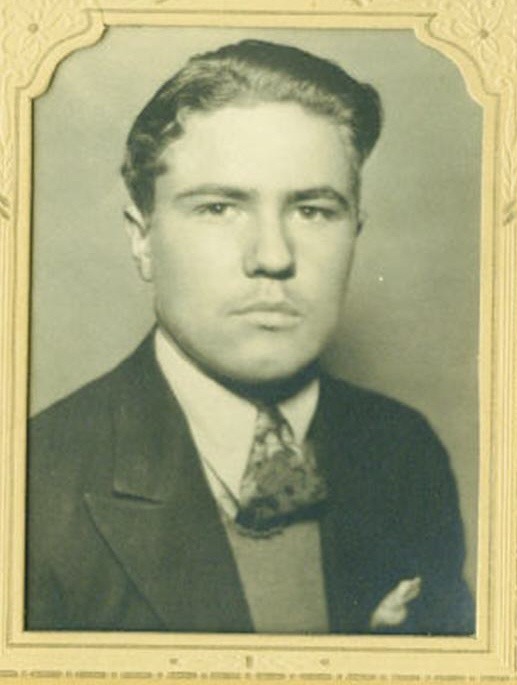
FRANKLIN (FRANKIE) MEYER (1919 - 1935) - Age 15

Photo: This is of Ray, about 6 years old, and Esther at about 1 year old. My guess us, she is wearing her hand-made christening gown ... maybe .… Debra, Ervin’s daughter has that chair.

Photo: Mother labeled this photo - 1925 .. a friend, Ray and Mother (Esther) in Madison. ... She was 16. Athletic Field in Madison probably doesn’t even exist.
Q 16. And, where were you all born.
A. We were all born in Wisconsin up by Reedsburg.
Q 17. When did you move down here (to Afton)?
A. I think it was 1939. We were married in 1928 in Baraboo.
Q 18. What brought you down this way? Was it his work?
A. Ervin brought us down. He was running a Singer Sewing Machine shop. Ray and Fola had moved down here, and we kept coming down o visit them. Art was down here, too. When my mother died, our family kind of broke up. We kind of followed Fola and Ray where ever they went. They lived on Bass Creek in Afton just west of the bridge. Ray built four houses along the creek.
Note: Uncle Ervin was certainly an entrepreneur. He went into business with his brother-in-laws Marx and Lentz. They built many homes in the Hawthorne Circle area. Both Uncle Ray and Grandpa Henry (Hank) worked for them. … Uncle Ervin had his own Singer Sewing Machine Shop and Antique Furniture Store on N. Main St., Janesville.
Today, the building is torn down. My grandfather, Henry Meyer would stay there often, and do lots of fishing along the Rock River. … Also, over a period from 1939 to 2001, Ervin ran many businesses: antique shops in Beloit and Janesville, and two separate resorts located around Hayward. ….. As well, he took an old barn south of Janesville on Oakley Rd., and turned it into Meyer’s sales. ... Uncle Ervin owned a cottage on Lower Eau Lake, which was about 20 miles north of Hayward off Hwy. 27. He owned it for close to 40 years. His family and our family spent many a vacation there. Plus, there were many of my brothers and sisters, and cousins, and extended families, and friends, who would few days, or more at the lake thanks to Uncle Ervin.

Interestingly, when Uncle Ervin bought the tiny cottage and three hundred feet of shoreline on the lake, he sold part of it to Uncle Ray and Aunt Fola. And, they built their own cottage on the lake. There were so many memories made up there.

That’s me at nine years old.

Note: This is Uncle Ervin’s cabin in the late 1980s. Over on the left is the mobile home my folks moved up to the lake. There was my dad’s pier on the left and Uncle Ervin’s on the right. About 100 feet to the right was Uncle Ray’s pier, and, his cottage is above that.
Q 19. What was it like when you went to school? Was it a one-room school house?
A. I went to a Christian School through eighth grade. It was one big room.
Note: Mother told me that she went to a Lutheran school for eight years. Then, she attended 9th grade at the Reedsburg High School. In fact, Carol found her name in the book, and she was tickled to hear that. It is in the book THE HISTORY OF SAUK COUNTY, WISCONSIN, about Sauk Co. which includes Reedsburg. Mother said that there wasn’t much work for her dad back then, so she quit and found a job so she could help her family out. That would have been right around 1924 or 1925. Again, times were tough as the United States was trying to recover from WWI.
https://archive.org/details/historyofsaukcou00west
Q 20. Did you have to carry water and wood for the school, like you hear? … Like other people talk about it?
A. No.
Q 21. Did you attend a church up there?
A. Yes, we went to church every Sunday. I was in Sunday school. We were always Lutherans. My mother had a German Bible. She could read German.
Note: Mother told me that her mother, Emma, went to church almost every day.
Q 22. Who got to keep that (the Bible)?
A. I don’t know who has that. I think I gave it to Mamie, (Emma’s cousin) cause she could read German.
Q. 23. Did your mom speak German to you a lot, or just English?
A. No, she just talked English, but my Aunt Ida talked German. She couldn’t speak much English. She was one of the older ones to come over with my mother. Every time you would go to visit her, she would give you a dollar bill. … I knew a few words in German when I was young, but I lost it. There are a few words I still know. I used to talk to people who only knew German, when I was little. Going to this German school; they taught both German and English.
Q 24. Where did your mom and dad meet?
A. I don’t know.
Q 25. How did you meet Uncle Bill?
A. It’s hard to remember. It’s been so long ago … I can’t remember. I think I was at a dance. My uncle was a dance instructor (caller of square dancing) and he would come down from Baraboo to Reedsburg, and me up and take me with him. He wanted to make sure us kids behaved themselves. That’s how I got to go to dances.
Q 26. Do you like to dance?
A. Yes.
Q 27. Did Aunt Mamie have any kids? (Asked by Linda)
A. She had three. Two boys and one girl. One of them, Harold Schultz, lived in Janesville. The other one worked in the post office in Chicago. The daughter died.
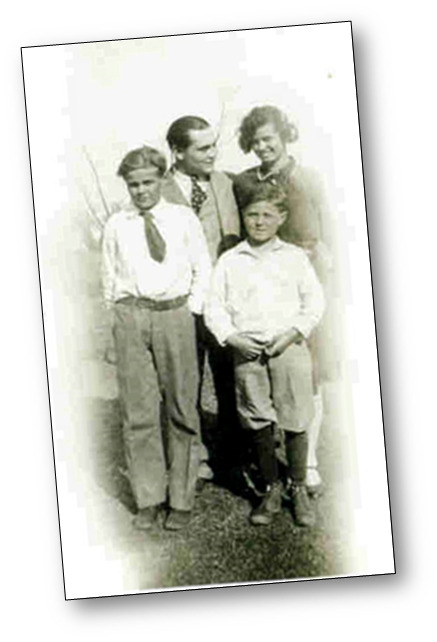
The photo was taken on Bill & Esther’s wedding day … April 22, 1928 with Ervin & Frankie … Esther bought Bill’s suit for their wedding.
Q 29. Didn’t you say a cousin has the Bible?
A. Yes, she (Mamie) is the one who got the Bible. Harold, her son in Janesville might know where the Bible is. Another cousin there in Janesville is an insurance man, I can’t remember the name.
Q 28. Who was Aunt Mami?
A. She was my mom’s cousin.
Q 30. (Carol) I worked with a lady who is a Schenck from Reedsburg.
A. There is a family up there (Schenck) spelled the same.
Q 31. Her father has a farm there in Reedsburg. His son has the farm. Do you know we are related to the Schenck’s up there?
A. Not that I know of.
Q 32. (Linda) Who was that cousin that lived on the farm down towards Beloit?
A. I don’t remember. … (Subject changed) … I think my grandfather was buried in Loganville up by Reedsburg.
Q.33. What was Art like growing up?
A. He was very bashful. He used to fight a lot with the boys. I used to tell mother to get after him. I used to catch him, and then she would spank him. Ha! Ha! Ha! (Mother was laughing.)

Photo: Art, Ervin & Frankie, We think this photo was taken in the middle 1920s. Frank looks like he is five, or so. He was born in 1919.
Q. 34. Do you remember how he (Art) met Vera?
A. I know he met her in Beloit, but I don’t know how.
Q. 35. (Aunt Linda) I thought he actually worked for a farmer?
A. Art had a girlfriend in Janesville, before he met Vera. I don’t remember name. I always liked Art. He was a likable guy.
Note: Donald Ahlquist, my brother-in-law, always joked about Art marrying the “farmer’s daughter.” You know … like the “farmer’s daughter story.” Don would laugh, and say, marrying the “farmer’s daughter.” You know … like the “farmer’s daughter story.” We all would la ugh, and say, “Art found work on a farm, and had to married the father’s daughter.” I have absolutely no proof. But, the story sounded good at the time. And, I remember chuckled about it. … And, I always believed it.
However, it is a fact that Vera was living in Beloit with her uncle, the Beloit Police Commissioner. Aunt Martha, Vera’s youngest sister and 15 years her junior, said that when Vera was a teenage, she was causing lots of problems at home. Of course, everyone knows that teenagers can cause lots of problems at home.
Q 36. (Carol) I feel bad that I didn’t get to know him (Art). The others were old enough, and out of their houses, to make the contact. I was young enough where I didn’t have access.
A. He was a nice person. He didn’t drink or smoke.
Q 37. Did he chase women?
A. Not very much, Ervin was the woman-chaser.
Q 38. How old is Ervin?
A. He is seventy-eight. (In 1993.)
Q 39. How old are you?
A. I’m eighty-four. (Again, in 1993)
Q 40. Do you ever wish that you had a sister?
A. Yes. My mother died when I was quite young. I grew up without a mother, or a sister. All I had was those boys!
Q 41. What was your dad like?
A. He was nice.
Note: His name was Henry Wilhelm (William) Meyer (1881 - 1961). I have very fond memories of him. My grandfather was quiet, and a very kind and patient sole. He seemed to always have a smile on this face, especially when fishing and playing Euchre. His laugh would warm all of our hearts.
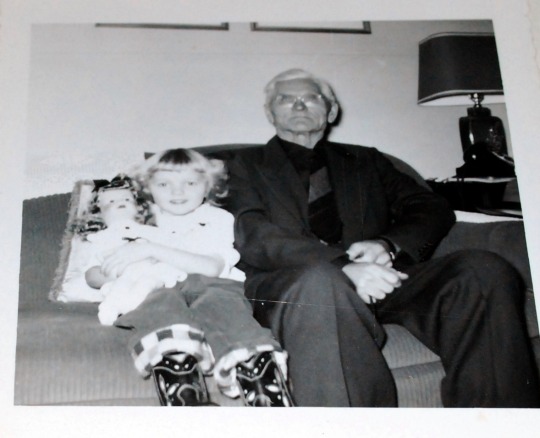
This was taken in 1951. I am three and sitting next to my Grampa Hank.
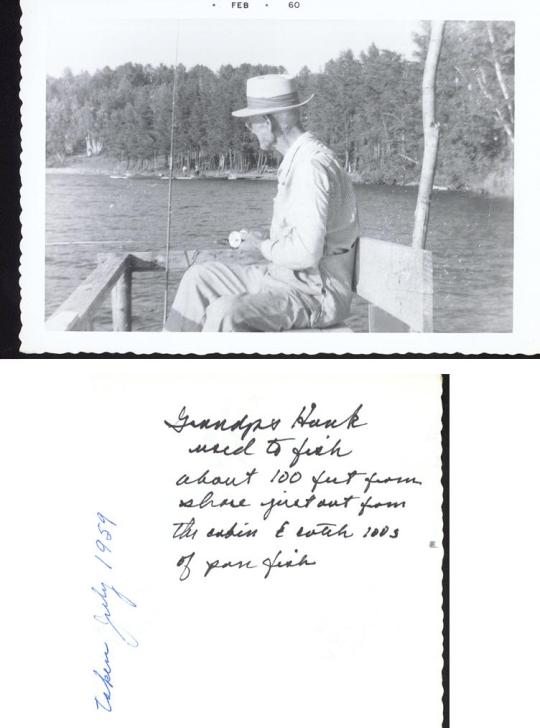
This was taken in 1959 of Grampa Hank. He used to fish about 100 feet from the shore just out from the cabin and catch 100s of pan fish. My dad, Bill Schenck, would complain, as he usually cleaned them all. When I was helping once in a while, my dad would have me throw the little ones back. Tsk!
Q 42. Were they all tall?
A. Dad was like Ervin. Art was 6’ 3”. Frankie was about the same.
Q 43. How did Frank die?
A. He drowned in the lake when he went fishing.
Q 44. Did they think he had a seizure?
A. Yes … nobody was by him. Uncle George (Bill’s brother) an Bill wanted to take him (Frankie) fishing. He was 15. I (Aunt Esther) told them I didn’t want him (Frankie) to go. They left him alone, and went up to the house. When they came back, he was gone. He had seizures. He was the nicest kid.
Note: Mother and I visited Uncle George (Bill’s Brother) on his 100th birthday in 1999. He seemed to be quite sound of mind. We talked a lot about the past. Surprisingly, during our conversation, he brought up Frankie’s death in 1935. My dad had already passed in 1989, and had never talked about it with me. Uncle George told me that Frankie was fishing out on a pier on along the Baraboo River, and Uncle George and dad went back to the car to get some fishing gear from the trunk. The car was just up over a knoll and out of sight of the pier. Frankie had a seizure and fell off the pier, and went under the water before they got back from the car. Immediately, my dad went into the water trying to find Frankie, while my uncle drove for help. The firefighters came, and it took almost an hour to find Frankie. The current swept him under an overhanging bank. According to my Uncle George, my dad never got over it, and blamed himself the rest of his life for Frankie’s death.
Here are a few photos from Mother’s album of Frankie.
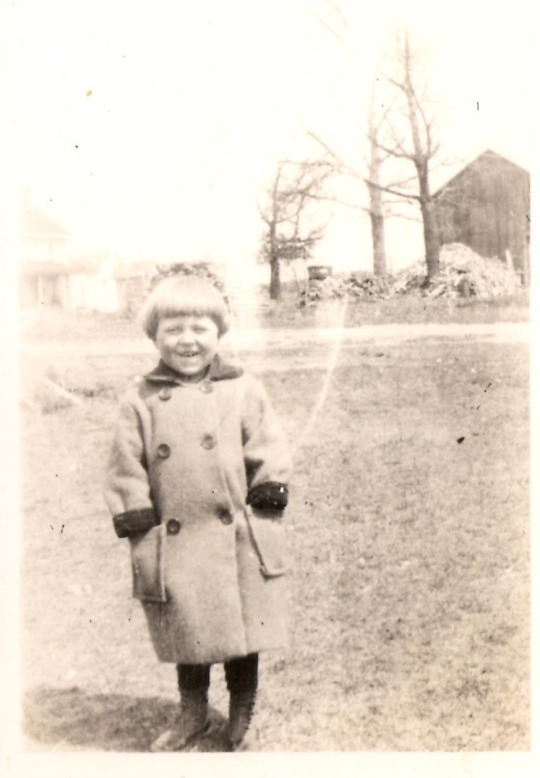
Little Frankie .... I think he was three or four here.
Frankie with his mother, Emma.
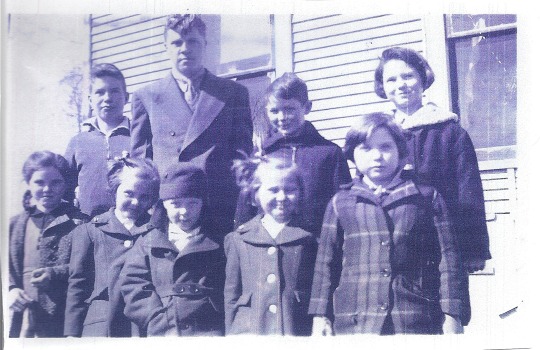
Back: Frankie Meyer, Leonard Meyer (Ray’s oldest son,) a friend, Dolores Schenck (Esther’s daughter, front: Sandy Meyer (Ervin’s oldest daughter,) Then, there is Jean, Leroy & Joyce - all Ray’s kids & a friend.
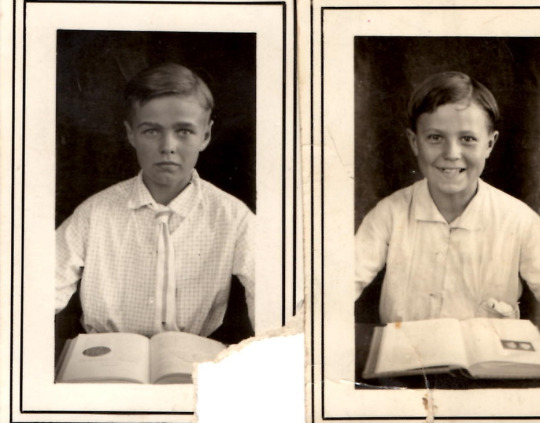
Ervin is on the left and Frankie on the right.
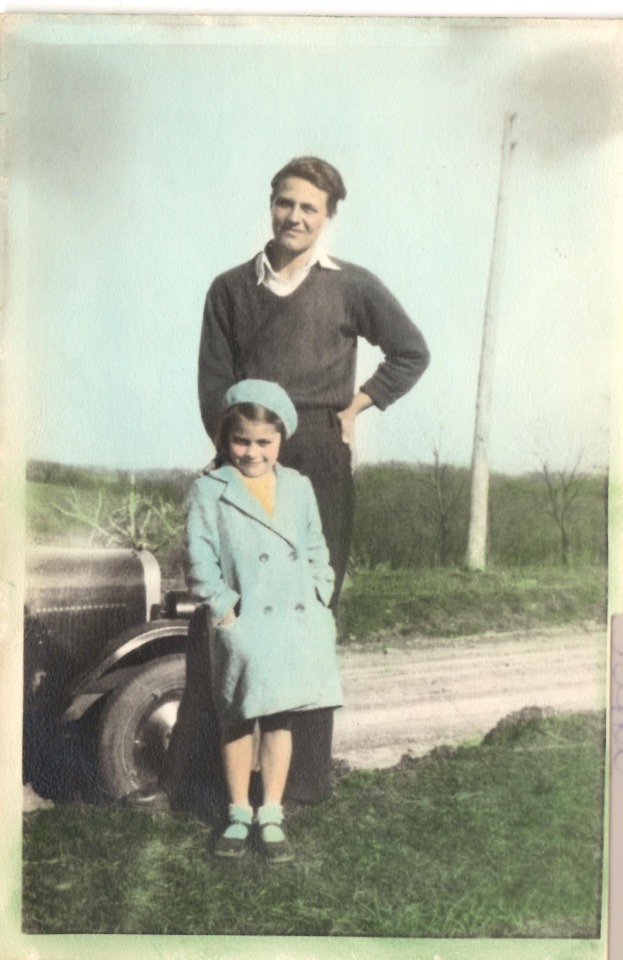
This is Frank with Dolores (Esther’s daughter.)
Q 45. Did Frank always have those seizures, or did he get sick and then get them?
A. He didn’t always have those seizures. He got them after his mother died. He got them when he was in his teens. Mother’s grandmother, Dorothea Magdelena Heitman Meyer, had them, too.
Note: Mother said that Frankie would have several of them a day. It is really sad. And, remember, Frankie’s grandmother had them the day she died according to her obituary.
Q 46. Your grandma who came over on the boat had them, too?
A. Yes, I think she died from one, too, because she was alone at home. They went to church, and when they came back, she was gone.
Q 47. How old was she?
A. She was in her sixties, I was just small when she died. I don’t remember her. I do remember my dad’s mother, Catharina Margretha (Behn) Meyer, though. I remember going to her funeral.
Obituary
Catharina Margretha Behn Meyer
Henry Meyer’s mother

Meyer
Mrs. Catharina Margretha Meyer, nee Behn was born Jan. 7 1845 in Oldendorf, Prov. Hanover, Germany. She was baptized and confirmed in Nohrendorf by A. Goegling, Pastor. She was married to George Meyer 1867. The same year they came to America and located in Loganville. This union was blessed with seven children—5 boys and 2 girls: Fredrick of Spokane, Wash., Mrs. Lizzie Kutzbach, town of Reedsburg, Wis., Herman at Reedsburg, Mrs. Lena Riley of Albion, Neb., August, Lime Ridge; Henry and Eduard at Reedsburg. Her husband died 12 years ago. She made her home since that time with her youngest son, Eduard where she died Dec7, 1922, aged 77 years, 11 months after an illness of about 2 years. The deceased leaves to mourn for her, one sister Mrs. Westedt in Wanebeck near Hamburg, Germany, also 30 grandchildren and 4 great grandchildren. The funeral was held Saturday, the 9th of Dec. from the St. John’s Lutheran Church conducted by the pastor Rev L. Schneider
Obituary for Emma (Meyer) Meyer
In Mother’s handwriting note above Emma’s obituary,
“Died in Madison Hospital recently.”
This was in the Reedsburg newspaper.
Mrs. Emma Meyer died in a Madison Hospital Feb. 26, 1930. The funeral was held from the Lutheran Church in Baraboo and interment was in Greenwood cemetery, Reedsburg. … Mrs. Meyer was born in Hanover, Germany, May 6, 1878 and when three years old her parents came to America and her early youth was spent on a farm near Loganville. … On April 16, 1903 she was united in Marriage with Henry Meyer and five children were born in this union. Raymond of Janesville; Esther, Mrs. Wm Schenck of Baraboo; Arthur, Ervin and Frank at home. Besides the family one sister survives, Mrs. Ida Blotkamp of Napoleon, Ohio.
On another note: There were two different obits. Sadly, when I found the second obituary, I found Mother had written, “BD 11-4-28 Died 11-5-28” … The small article read,
“Twin Baby girls were born to Mr. And Mrs. Willis Schenck of this city at St.Mary’s Ringling hospital Sunday, one of the little girls passed away this morning. … 11-5-1928.”
Mother said that the doctor called her a “blue baby.” … Dolores’ twin was named Mary Magdelena Margareta (Esther’s grandmother’s middle names.) … Today, “blue baby” means Mary had a hole in her heart. We don’t know if Dolores had a damaged heart. However, when my dad had open-heart surgery in 1985, he had three blocked arteries, and a valve needed replacing. I always said that he had a “tune- and a valve job.” He lived four more years. Anyway, it was during that surgery when the doctors found out that he had a small hole in his heart, like “blue babies.” They fixed it.
Note: Emma died at age 52. ... Here is interesting story. … My sister-in-law Cleo, Dale’s second wife, had cancer. My mother and I went to visit her on the day just before her passing. We had a lovely visit. However, on the way home, my mother said very quietly, “My mother (Emma) had a stomach that looked just like Cleo’s.” … Mother could not say the word “cancer.”
Emma had been taken to the Madison hospital for a few days prior to her death. But, back in 1930, no one spoke the word “cancer,” because it had a stigma, and was usually only whispered. If Emma had cancer, it was never mentioned. She could have had ovarian cancer. … Esther had a hysterectomy, and she said the doctor said it could have become cancerous. I was eight at the time. She was 47. When I was 42, I too, had a hysterectomy, and the doctor told me it was pre-cancerous.
Q 48. How old were you when your parents died?
A. I was 22 when my mother died in 1930, and my dad died in 1961.
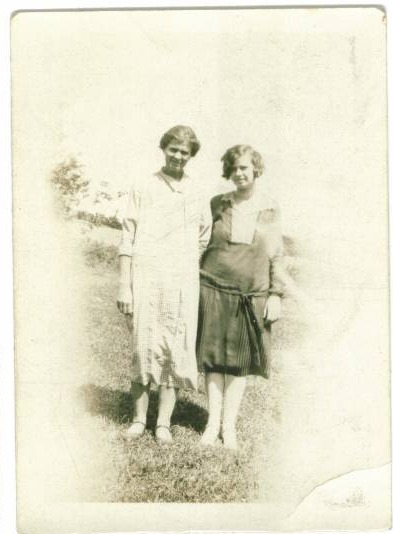
Left: Emma Dorothea (Meyer) Meyer … Right: Esther Ida Mae (Meyer) Schenck … This was taken on Esther and Bill’s wedding day, April 22, 1928. According to my mother, this was the only picture taken of the two of them together that she had.
Q 49. So, your mother was fairly young when she died. What did she die from?
A. I don’t know. They took her to Madison and the doctors said that she was just “all worn out. She did too much.”
Q 50. So, everybody was pretty much older, except for Frankie then, right?
A. Yes.
Q 51. What do you remember about World War I? Do you have relatives who fought in it?
A. No, I can’t remember World War I.
Q 52. What do you remember?
A. We lived out on a farm near Reedsburg. They came to our school and told us about it. One of the neighbors picked all of us kids up and took us to town.

Photo: This is our grandfather on the right and his friend on the left. According to Mother, someone asked her dad to join the Wisconsin National Guard. Her mother was extremely upset, and begged him not to go.
Note: While looking up information on the Wisconsin Guard history, I found:
“The 1st, 2nd, and 3rd Infantry Regiments were mustered into Federal service on 30 June 1916 For Mexican Border service. The Guard Unit's Troop A and Troop B were mustered out of Federal Service on 20 October 1916 and 6 March 1917, respectively. The regiments were mustered out at Fort Sheridan, Illinois, on 19 January 1917 (1st), 28 February 1917 (2nd), and 14 December 1916 (3rd).”
Henry actually volunteered. However, after two days with the Guard, he was sent home, as he had children at home to feed. Consequently, his name was not entered into the Guard roles. That was the practice back then. Mother said that her mother (Emma) was so relieved he didn’t have to go.
Q 53. Do you remember if any of your brothers were in that war?
A. No, but Bill’s brother, Clarence Schenck, fought in it. His brother came home with some kind of disease.
Q 54. Was the Depression hard for you?
A. Yes, We didn’t have anything. No money, or anything. Bill worked wherever he could find anything to do. He used to go out to hunt and fish.
Note: Mother told me about when they lived across from a creamery. Dolores was a little baby. My dad would sneak ice cream out of the creamery for them every day.
Q 55. Did you live in Afton at the time?
A. No. (Reedsburg)
Q 56. When did you move to Afton? The house you lived in when I was little?
A. 1939. We built that house. Ray and Bill built it, because we didn’t have much money.

Note: The little house on Bass Creek. It’s size was 20’ x 30’. It was down two houses from the Afton Feed Mill. It was torn down in the late 1980′s.
Q 57. I remember you had a washing machine with a window in front.
A. The Westinghouse (washer).
Q 58. I have very few memories of me (Carol) as a little girl, but I remember you had a washing machine where you could see the clothes going around and around. Did I spend much time with you?
A. Yes, you used to come over once in a while. We would kind of take turns with the boys and girls. There were too many of you to have you at once.
Q 59. When Linda came along, did you pretty much care for her? Was Vera up to caring for her at all?
A. She (Vera) did some. It was mostly Dale that did an awful lot. He even tried to bathe her. It was somebody’s birthday, and he baked a cake.
Q 60. Dale tells a story about when we were building the house on Turtle Creek, that there was an army tent with an entrance, and that we kept a cow in the entrance to keep the heat in. Do you remember anything about the tent when they were building that house?
A. I don’t remember a tent.
(Linda) – I don’t think I was born yet. …
(Carol) – I’m not even sure I was…. Ha!
Q 61. Did Vera or Art have a Violin?
A. No, but my dad made a violin.
Q 62. Could any of them sing, or you?
A. I can’t carry a tune.
Q 63. (Carol) In the house by the creek … I can remember going into a bedroom and seeing a violin in the bottom dresser drawer.
A. It was probably Dad’s (Henry) ... Dolores took lessons on a Hawaiian guitar. Dad (Henry) used to play the violin all the time. I wanted it as a keepsake. I don’t know who got it. I don’t think Art had that one. My uncle made each of his kids one. … My dad and his brothers used to have an orchestra.
NOTE: It probably was not an orchestra. Mother told me that he played at barn dances and weddings. … She was just tickled when she told me about her wedding. Her dad threw her a huge party … you guessed it … a huge barn dance. You have to remember, the Meyer/Meyer family had lots and lots of relatives, and friends. Gramps put on a huge celebration for her wedding. And, she told me then, the “guys in his and played.”
Q 64. Q. Could any of them sing, or you?
A. I can’t carry a tune. Linda has a pretty voice. Linda won first place in a talent contest. Michael has a nice voice, too.
Note: I actually won five talent contest. Two in Footville during “Farmer Days.” with Connie Carlson, and three at Rock Consolidated in 6th, 7th and 8th grades.
Q 65. Do you remember any old history things that your family told you?
A. No.
Q 66. Was anyone in your family a bank robber, or cowboy?
A. No. The only thing that happened in our family was our grandpa committed suicide.
Q 67. Who?
A. Grandpa George Meyer (Henry’s dad).
Q 68. Do you know what the circumstances were, and why he did it?
A. They said he was very jealous of his wife. I don’t remember much. He shot at her first, but didn’t kill her. She lived for quite a few years.
Q 69. Did she have a male friend?
A. No, I don’t know how true it is.
Q 70. Is there any Indian blood in us?
A. Grandpa (George) was always saying that, but he was just kidding.
Q 71. Who was it who said that your mother wasn’t your mother?
A. Joyce’s daughter, Laura, who was looking up the Meyer family tree. She thought she found out that my mother was not my mother?
Q 72. Is it true?
A. No. Ray said he was right there when I was born. He said that they put me in a shoe box, because I was so tiny. They found on her records that things were all mixed up.
Note: I am guessing that she was a “preemie.”
Q 73. Who did she think is your mother?
A. She didn’t find it, but Ray says it’s not true. They have got my record up at the Reedsburg church. I was one of the first children baptized in the big Lutheran church. They have the record of my family, and when my mother and father were married.
Q 74. Then, you weren’t adopted and left on a doorstep?
A. No. In those days, they didn’t keep such good records.
Q 75. Did Ida Mae have any children?
A. No, she never had any children. She was married twice.

Aunt Ida (Meyer) Blotkamp at age 75
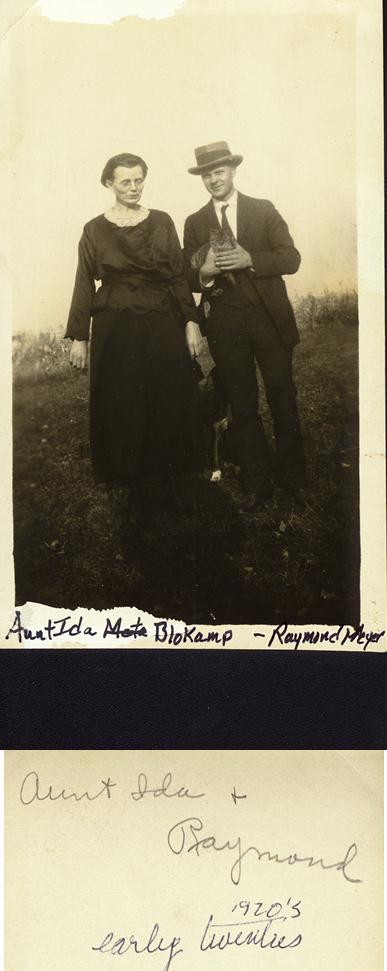
Q 76. Is she your mother’s sister?
A. Yes
Q 77. Older or younger?
A. Younger. I don’t know how much younger. Aunt Ida used to come on the train once in a while to visit us. She came when Linda was a little girl. She used to take care of her (Linda) and walk with her down by the (Bass) creek.
Note: Prior to Great Aunt Ida’s passing, she was probably afflicted with Alzheimer’s. My mother and dad and I would often ride up to Baraboo to visit relatives. Mother’s Aunt Ida was on the list of stops one time. I was probably 10, or so. I remember watching Mother walk up to the door and knock. Aunt Ida answered the door, and would not let Mother in. Aunt Ida did not recognize her. …Most likely Alzheimer’s. My mother was pretty shook up about it, to say the least. Aunt Ida lived to be 82.
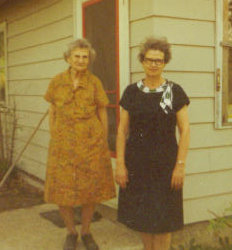
Photo: When I found this picture, I was shocked. What shocked me was how much Mother looked like her. At age 92, she was the spitting image of her Aunt Ida. Mother would be proud.
Another thing … Mother told me something her Aunt Ida told her that she never forgot. My mother had sewn something she was very proud of. … Mother would sew dresses for Dolores, and for me. Some of the dresses were beautiful.
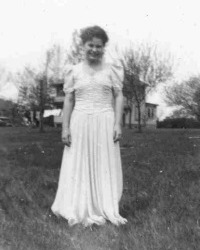
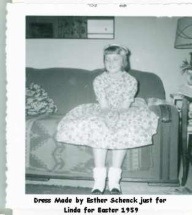
Yes ... she even made me a matching bonnet.
... So, one day, Mother took something she had sewn up to show her Aunt Ida. … She couldn’t believe what Aunt Ida told her, “You will never sew as good as your mother.” … oowwww, I bet that hurt.
Green Wood Cemetery, Reedsburg, WI

Q 77. (Linda) – Here we have the Cemetery. What is that cemetery across the road from Green Wood Cemetery – What is its name?
A. St. Peter’s (Aunt Esther is pointing out different parts of the cemetery where anyone can be buried, and where only the Lutherans can be ... buried.) My grandma is up here. My Mother has a sister buried down here (Catherine Wilhelmine Dorothea Meyer) near the end (of a lane.). And, that’s where only the Lutherans can be (buried.) She decided when she was a little girl, she was going to be buried up near there (pointing out of the area.) Her name was Meyer.
Q 79. How far down would any of the relatives be?
A. My grandma is about halfway up the hill, where it says Schultz.
Q 80. What was her name?
A. Katherine.
We are getting out of the car to go look at head stones.

Photo:
Left: Henry W. Meyer’s stone
Right: Frank & Emma Meyer’s stone
Q 81. Your mother and father’s names were what?
A. Emma and Henry. I know my grandma wouldn’t have a marker, because my folks never put one in. I don’t think this is it. I have a Katherine Schultz. She isn’t a Shultz anymore.
Q 82. Who is Uncle Doug?
A. My uncle, my dad’s brother’s: Uncle Herman, Uncle Ed, Aunt Emma and Uncle Gus.
Q 83. How do you know if you are related, or not, to some of this other Meyer’s here?
A. I just know my relations. If you see a Donald Meyer, that’s a relative also. This is the small Lutheran church. The big Lutheran church is up there. (Mother points towards the top of the hill. Aunt Emma and Uncle Gus are buried here. (Linda began listing off different Meyer names that were listed below her parents to see if Aunt Esther recognized them.) I was at Aunt Emma’s funeral. Hers (headstone) is out further toward the front. There’s a Fisher. I used to go to school with Ida Fisher out in the country by Loganville.
Q 84. Here are Katherine and Edward Meyer.
A. That would be Uncle Ed and Aunt Katie. They did belong to St. John’s (Lutheran.)
Q 85. (Linda) Did you belong to St. John’s?
A. I belonged to St. Peter’s.
(We get out again to look at more headstones.)
Q 86. Who are these people? Their child?
A. Louisa is my Aunt and Herman is my Uncle and this is my cousin.(Pointing) Yes.
(Getting into car)
A. …. Two guys came from Germany, and they used to come and visited us when we lived on the farm. They settled in New York.
Q 87. Who was that?
A. Some relatives of my mother’s. I don’t remember their names, but I know they are in New York. …
We are driving (Pointing) My dad built that house.

This was taken before 1909 prior to the fire that burnt it down.
Q 88. (Linda) What are the names of your cousin?
A. Crystal (?). Thelma, Edna Alma, Florence. They had two boys, one is now in Janesville. All got different names. Their maiden name is Schultz.
(BREAK) We stopped at Mother’s favorite restaurant in downtown Reedsburg for lunch, before we left for home.
Q 90. Who all had the flu?
A. Mae and my dad. They were so sick. They were sick at least a couple of weeks. We lived upstairs.
Q 91. Who did you live above?
A. Skinners, our neighbors across the road, their boys set our house on fire.
Q 92. How old was he?
A. Eight or nine. Yes, it burnt to the ground. People at the church treated us really good. They gave us all kinds of things like quilts, dishes and whatever we needed. A girl told me in school that she had something to tell me, if I didn’t tell anyone. She told me what they (the Skinner boys) did as soon as I got home, I told my dad. He got some money out of it. I don’t remember how much. (Inaudible)
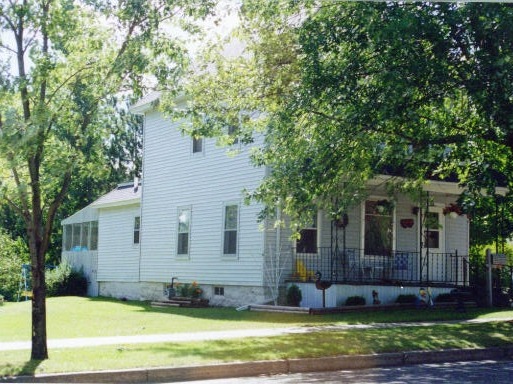
Photo: This is the house that Henry rebuilt their house. Well ... it has probably been remolded ... probably several times. It was on the same spot where the former house that was burned to the ground. I did not take this photo. This was mother’s photo.
Q 94. Did you have far to walk to school?
A. No, we lived maybe a mile from town. It wasn’t very far.
Q 95. Did you ever ride a horse?
A. No. I think we had horses. I don’t remember the horse, but I remember the cows. Dad used to go down to the barn and milk the cow every morning and night. We had chickens. We used to take eggs to town and trade them for groceries. We didn’t get very many groceries. It isn’t like it is now. I remember milk being seven cents a quart. The guy used to deliver it to the door.
Stories about us kids
Q 96. What do you remember about Dale as a young boy?
A. I took care of Dale a lot. He wasn’t bad at all. I never had any trouble with him. Just once I remember getting into an argument with him. We always got along pretty well.


Photos: Top: Uncle Bill with Dale and Roy sitting on his pier along Bass Creek.
Bottom: Two cutie-pies Dale and Roy.
Q. 97. Do you remember anything in particular about Roy?
A. Yes, one time he was riding a bicycle in Afton, and hit a tree. It knocked him onto the ground. I didn’t know what had happened. He came in the house, and acted like something had happen to him. I didn’t know what to do. We should have taken him to the doctor right then and there. He came out of it ok, though. But, I worried about him. He must have been seven or eight. … The time he was staying with us.
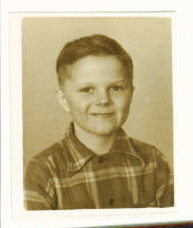

Dale, Roy and Ralph
Q 98. What about Ralph?
A. I can remember Ralph at your place down by the creek. (Turtle Creek) Your mother (Vera) picked up a great big stick, and whipped him across the calves of his legs. Boy, I bet that hurt. I remember that. … One time he came over, and he and I went fishing down by the creek. (Bass Creek) Ralph never got to come over as much as Dale and Roy.
Q 99. Why do you suppose?
A. I don’t know.

Q. 100. What about Nina?
A. She was over quite a lot. She used to come over to Delavan, too, and stay with us. One time, I bought these corn curls, or something, and those girls ate the whole bag. I couldn’t send her home. I had to wash all of those clothes.
Note: (Linda) I puked all over the rug, too. And, to this day I still hate corn curls. (Ha!)
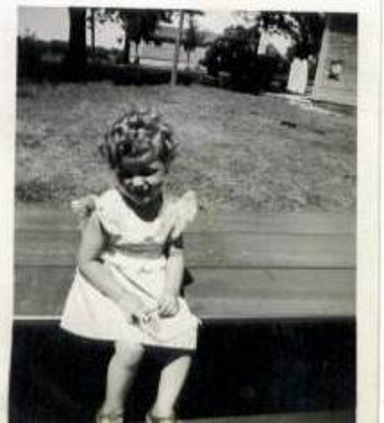
Carol at three or four.
Q 101. What do you remember about me (Carol asking)?
A. You were a cute little thing. You had curly hair. It was natural and really curly.
Q. 102. Where did it go?
A. I don’t know.

Johnny at about one year old sitting on Uncle Bill’s lap.
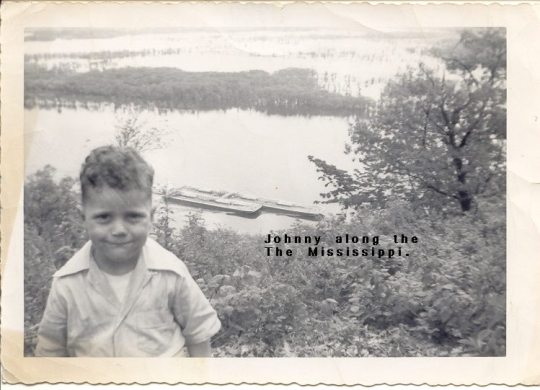
Johnny along the Mississippi
�� What a cutie!
Q. 103. What about Johnny?
A. Johnny … I didn’t have him very often. I wanted to keep him. But, Dale and they wouldn’t let me. It was too hard on me to take care of him. I have pictures of Johnny when he was staying with us. I remember Grandpa Charles Schenck (Bill’s dad) was living with us then Johnny was staying with us. Johnny was the biggest cry baby. Grandpa would shake him and hold him on his lap ... shake the buggy when he was in it.
So, was Roy. He was a real crier, even as he got older. He made the loudest noise. One time Vera and Art left him with me, when they went somewhere. He bawled all day long. I couldn’t get him quiet. He was just a baby then.
One time, we went up to Clarence’s (Bill’s brother in northern Minnesota) and we took Dale and Roy with us. Delbert (Clarence’s youngest son) was little. It was before he had polio. Delbert had a lot of toys. Roy stuffed his pockets full of those toys to take home. He didn’t understand that he couldn’t. We had some fun with those kids once in a while.

Photo: That’s me ... little Linda ... Mother had two colored pictures which were made from B&W prints. This one, and the picture of Frankie and Dolores. Although Mother said how she had them in color, I am wondering if Mother’s neighbor in Afton painted on them? The neighbor was an excellent painter. She made a pair of beautiful paper mache figurines for Mother, which I still have. Oh, I forgot our 1957 reunion photo.
Q 104. What about Linda before you got her for keeps?
A. I remember going over there to get her, and Nina would say that this baby belongs to them, and not to me. Linda was only eight or nine months old when I took her. I don’t know who took care of her over there. I guess they all did.
Q 105. (Carol) I think it’s amazing that we all lived when we were on the creek. (Turtle Creek)
A. I brought plenty of groceries for you to eat, but there was no one there to fix it.
Q 106. No, I mean as far as not falling into the creek, because it’s all open. I’m surprised no one drowned...
A. Someone must have kept their eye on you.
Q 107. When you went to adopt Linda, when you went to the court house, was I adopted the same day? I remember being at the Court House, and I think you were there at the same time?
A. Must be, I don’t remember.
Q 108. I can vaguely remember … was Art there sitting on a bench?
A. Yes, they had to sign you kids off. Art didn’t want to do it, but they made him.
Q 109. Who made them do it?
A. The lawyer … and that Vera had control of the kids. When they were divorced, Vera got custody, and had the say so of where the kids went. When she couldn’t take care of you, you were put up for adoption
Note: Vera told me (Linda) several times that she knew that she couldn’t take care of the seven of us, and that she “wanted better for all of you.” I remember seeing her when I was 14 down in Beloit above Ervin’s store on State St. Then, when Kristie and Michael were five and four, we met Nina at this motel on Hwy 51 near the bridge to meet Vera. Nina and Peggy were there.

Peggy and Vera and a friend.
Then, I visited her four times when she was living at the YMCA in Madison. Each time I saw her, I asked, “Why did you give us all away?” Her answer was always, “Because I wanted better for all of you.”
As I sat typing this, I decided to look up what it was like economically back in 1949. After reading the information below, I understand better. It seems to me that I can accept her explanation.
A BRIEF LOOK BACK TO THE ECONOMY IN 1949
“Recession of 1949
… was a downturn in the United States lasting for 11 months. According to the National Bureau of Economic Research, the recession began in November 1948 and lasted until October 1949.
The 1948 recession was a brief economic downturn; forecasters of the time expected much worse, perhaps influenced by the poor economy in their recent lifetime. The recession began shortly after President Truman's "Fair Deal" economic reforms. The recession also followed a period of monetary tightening by the Federal Reserve.
“During the recession the GDP of US
During this recession, the Gross Domestic Product of the United States fell 1.7 percent. In October 1949, the unemployment rate reached its peak for the cycle of 7.9 percent.
“Main causes of the recession
Many regard World War II to be the main cause of the recession. According to C.A. Blyth "the most important cause of 1948-1949 recession was substantial fall in the fixed investments".
“The severity of this recession
Maximum unemployment was about 7.9%. Change in Gross National Product GNP reduced by up to -1.5%. Department store sales fell 22%. The wholesale price and cost of living indexes fell 12 and 5 points. https://en.wikipedia.org/wiki/Recession_of_1949
Q 110. But, when they got adopted, why couldn’t he (Art) say, “No, you can’t have them?”
A. It didn’t do him any good. They wouldn’t listen. The lawyer made quite a bit of money when you kids were adopted. He got so much for each kid.
Q 111. Do you remember who handled that?
A. I think he was from Janesville. I know I have it somewhere.
Q 112. How much money did each of the parents have to pay to adopt us kids?
A. I don’t remember.
Q 113. (Carol)There was a guy in town that was like a cousin to my mother, but he wasn’t blood line. My mother’s natural mother died when she was a girl. Her father remarried and that was Grandma Tillotson. Then, Grandma Tillotson had a nephew, Leon Stenerson, who sold insurance. It was my understanding that Leon knew Art and Vera and their circumstances. Because he knew Helen and Carl didn’t have any kids, he set them on to getting Roy and me. Were you aware of any of that?
A. No
Q 114. I was wondering how I got to where I was.
A. Well, Dale never should have never been adopted. He was too old.
Q 115. How old was he, thirteen or so?
A. Yes, thirteen or fourteen. But, they put it through anyway.
Q 116. Didn’t the Bovee’s and Beckman’s somehow know Art?
A. I don’t know if it was Art, or if Vera got a hold of them somehow.
Q 117. I was just curious on how word got out that these kids could be adopted.
A. There was somebody who wanted Linda because she was a baby. We took her up there, and she stayed with them a couple of days, I guess. Then, the lady called me up and said I had better come and get her. (The lady was a nurse and had hired a nanny to help take care of me.)
Q 118. What was wrong with her?
A. She cried all the time. They couldn’t quiet her. She showed me where Linda’s room would be, and it was up on the third floor and they were going to have a special maid to take care of her. She would have had it really nice there. But, she cried, and she came back ok.
Q 119. Did they live in Janesville?
A. No, Beloit.
Q 120. Do you remember their names?
A. No, they were through Art somehow.
Q 121. The only thing I remember is that I think Art came over to our house a couple of time.
A. I don’t think that Carl and Helen wanted him around.
Q 122. That was my understanding, he was kind of shunned aside.
A. I don’t think Beckman’s cared. The Bovee’s didn’t want him around either. It didn’t make any difference to me, because he was my brother.
Q 123. I can remember a couple of dinners all of us had afterwards. A holiday dinner, or something, and all of us got together at our house or something. That was fun. I used to have a picture, but I don’t know where it is anymore. It was around my mom’s dining room table. That’s my goal in life. To get all, every one of us together, before one of us dies. We always miss getting all seven.
A. That’s right; you haven’t been together in a long time.
Q 124. Since I was thirteen and we were out at Bovee’s, the boys were in the service and were home and in their uniforms.
A. I remember that. I gave somebody a picture of all three of them in their uniforms. I think I gave it to Joyce Bovee. You can ask her if you want to copy of it.
Q 125. (Carol) I’ve got the family one, with the three boys and all of us.
A. Santa Claus came in with one of those suits on. He was kind of a tall guy. He was somebody’s friend. You (Carol) ran and hid and would not come out while he was there. That was cute. I used to wrap all kinds of little presents and put them under the tree so you kids would have lots of presents to unwrap. (Mother meant she would take presents to Art and Vera’s house.
Q 126. You guys must have done a lot for us. You had us over a lot.
A. If I would have had more kids myself, I probably wouldn’t have done so much. But, seeing you kids needed help, I had to do it.
Reunion of 1957

1957 -- Dale, Roy, Ralph, Nina, Carol, Johnny and Linda
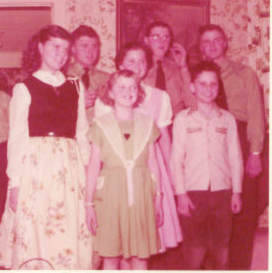

I have three photos from the 1957 reunion ... of the adoptive parents. ... Sorry about the scribbling.

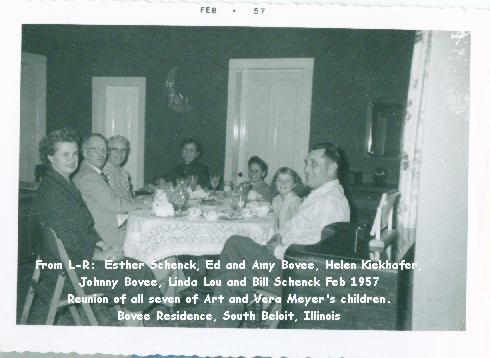
The picture above is actually Carol’s mom's house (Kiekhafer) - with her bedroom door right behind and the bathroom door to the left of that and the kitchen door to the left of the bathroom one. It shows my mom's nick-knack shelf on the far wall shaped like a crescent moon that Uncle Lester made my mom and some point..
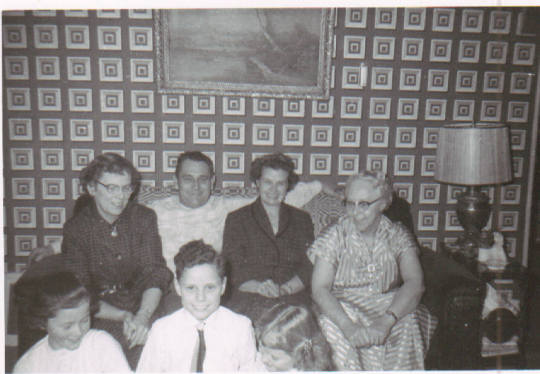
Parents: Helen Kiekhafer, Bill and Esther Schenck and Amy Beckman. Down front: Carol, Johnny and Linda
Reunion of 2007

CAROL’S WISH WAS GRANTED. ... for us all to be together 50 years later. ... This photo was taken in 2007 at the Water Tower Park in Clinton, when John Bovee came out from West Virginia for our 50-year family reunion. ...
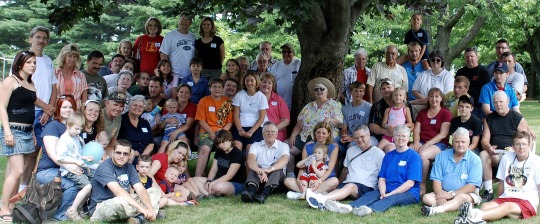
Meyer Group photo taken 2007. I count 73 heads.
0 notes
Text
Iconic Classical Music Pieces for Kids
Game 1, Game 2, Game 3, Game 4, Game 5, Game 6, Game 7, Game 8, Game 9, Game 10, Game 11, Game 12
The Hoffnung Music Academy, The Hoffnung Symphony Orchestra, The Hoffnung Maestro, and so on...
The Pink Panther in "Pink, Plunk, Plink"
Mickey Mouse: The Band Concert
Silly Symphony - Music Land
Tekfen Filar-Mini Belgeseli with Serra Yılmaz
-
Ludwig van Beethoven, Symphony 9, 2nd movement - Daniel Barenboim/West-Eastern Divan Orchestra
Ludwig van Beethoven, Symphony 9, 4th movement, Ode to Joy (excerpt) - Franz Welser-Möst/Vienna Philharmonic Orchestra and New York Choral Artists (alternative - final chorus - Leonard Bernstein/Vienna Philharmonic Orchestra)
Richard Wagner, Ride of the Valkyries - Daniel Barenboim/Berlin Philharmonic Orchestra (alternative 1 - Mark Wigglesworth/National Orchestra of Wales) (alternative 3 - from Star Wars)
John Williams, Imperial March from Star Wars - Franz Welser-Möst/Vienna Philharmonic Orchestra (alternative - George (Jiří) Korynta/Prague Film Orchestra)
John Williams, Duel of the Fates from Star Wars (alternative 1 - Ulf Schirmer/Münchner Rundfunkorchester and Chor des Bayerischen Rundfunks) (alternative 2 - Diego Navarro/Tenerife FIlm Orchestra & Choir)
George Frideric Handel, Hallelujah Chorus from Messiah - The Mormon Tabernacle Choir and Orchestra at Temple Square
Pyotr Ilyich Tchaikovsky, 1812 Overture Op 49 (excerpt) - Mark Elder/Hallé Orchestra (alternative - Erich Kunzel/Cincinnati Symphony Orchestra)
Edvard Grieg, In The Hall Of The Mountain King - Jacek Kaspszyk/Warsaw Philharmonic Orchestra (Concert for Kids)
Ludwig van Beethoven, Symphony 5 - Gustavo Dudamel/Orquesta Sinfónica Simón Bolívar de Venezuela (alternative - from Disney’s Fantasia 2000)
Ludwig van Beethoven, Für Elise by Georgii Cherkin - Grigor Palikarov/Classic FM Orchestra
Johann Sebastian Bach, Toccata and Fugue in D minor by Hans-André Stamm (alternative - performer is unknown)
Johann Pachelbel, Canon in D major - Adrian Leaper/Orquesta Sinfónica de RTVE (alternative by San Francisco Early Music Ensemble Voices of Music)
Antonio Vivaldi, Four Seasons - violin by Alexandra Conunova - Orchestre International de Genève (alternative 1 - violin by Fabio Biondi - Europa Galante) (alternative 2, Summer) (alternative 3, Presto from Summer) (alternative 4, Winter) - all by Mari Silje Samuelsen (alternative 5, Spring, 1st movement - Ashot Tigranyan/Classical Concert Chamber Orchestra) (alternative 6, Autumn - Frederieke Saeijs/Netherlands Symphony Orchestra)
Wolfgang Amadeus Mozart, Eine Kleine Nachtmusik, 1st movement - David Grimal/Les Dissonances (alternative by Gewandhaus Quartet) (KV 525 by Gewandhaus Quartet again)
Gioachino Rossini, Barber of Seville - Andrés Orozco-Estrada/Tonkünstler Orchestra
Samuel Barber, Adagio for Strings - Michael Neumann/Folsom Lake Symphony Orchestra (alternative by DJ Tiesto)
Carl Orff, Carmina Burana - Shin-ik Hahm/KBS Symphony Orchestra
Richard Wagner, Here Comes the Bride by Randy Dunn (alternative by String Quartet)
Richard Strauss, Also sprach Zarathustra (excerpt) - Gustavo Dudamel/Berlin Philharmonic Orchestra (alternative - 2001 A Space Odyssey opening by Stanley Kubrick)
Gioachino Rossini, Overture to William Tell (excerpt) - Edo de Waart/Milwaukee Symphony Orchestra
Wolfgang Amadeus Mozart, Symphony 25, 1st movement - Leonard Bernstein/Vienna Philharmonic Orchestra
Richard Strauss, Blue Danube Waltz - Franz Welser-Möst/Vienna Philharmonic Orchestra (alternative - André Rie/Johann Strauss Orchestra)
George Gershwin, Rhapsody in Blue - from Disney’s Fantasia 2000 (alternative by Lang Lang - Christian Thielemann/Staatskapelle Dresden Orchestra)
Pyotr Ilyich Tchaikovsky, The Nutcracker, Op 71 by New York City Ballet (alternative)
Christian Petzold, Minuet in G major - not Bach
Wolfgang Amadeus Mozart, Ave verum corpus K. 618 by King's College Cambridge
Jean Sibelius, Finlandia - from Wild Scandinavia
Gustav Holst, Mars and Jupiter - Bruce Engel/Stony Brook Wind Ensemble
Giacomo Puccini, Nessun Dorma by Pavarotti (alternative)
Ruggero Leoncavallo - Vesti la giubba by Pavarotti
Pyotr Ilyich Tchaikovsky, Sleeping Beauty Suit - from Disney (alternative)
Johann Strauss, Radetzky March - Daniel Barenboim/Vienna Philharmonic Orchestra 2014 (alternative 1 - Herbert Von Karajan/Vienna Philharmonic Orchestra 1987) (alternative 2 - Zubin Mehta/Vienna Philharmonic Orchestra 1999) (alternative 3 - Franz Welser-Möst/Vienna Philharmonic Orchestra 2011) (alternative 4 - Mariss Jansons/Vienna Philharmonic Orchestra 2016) (alternative 5 - Gustavo Dudamel/Vienna Philharmonic Orchestra 2017) - from all the best conductors.
Ludwig van Beethoven, Moonlight Sonata by Valentina Lisitsa
Wolfgang Amadeus Mozart, Symphony 40 - Frans Brüggen/Orchestra of the Eighteenth Century
Pyotr Ilyich Tchaikovsky, Romeo and Juliet Overture - Valery Gergiev/London Symphony Orchestra
Johann Sebastian Bach, St. Matthew's Passion - opening and final - Dan-Olof Stenlund/Malmö Chamber Choir and Orchestra
Jacques Offenbach, Can Can from Orpheus in the Underworld - Nejc Bečan/Gimnazija Kranj Symphony Orchestra
Claude Debussy, Clair de Lune by Kathia Buniatishvili (alternative 1 by Angela Hewitt) (alternative 2 - Jean-Christophe Spinosi/Frankfurt Radio Symphony Orchestra) (alternative 3 - violin by Mari Lee - piano by Dina Vainshtein)
John Philip Sousa, Stars and Stripes Forever by United States Marine Band
Hector Berlioz, Symphonie Fantastique - Mariss Jansons/Bavarian Radio Symphony Orchestra (alternative 1 - Colin Davis/London Symphony Orchestra) (alternative 2, 5th movement - Leonard Bernstein/Orchestre National de France)
Frédéric Chopin, Etude Op 25 No. 9 by Valentina Lisitsa
Johann Sebastian Bach, Cello Suite No. 1 in G major by Mischa Maisky
Franz Liszt, Hungarian Rhapsody No. 2 by Lang Lang
Giuseppe Verdi, La Traviata by Plácido Domingo, Luciano Pavarotti, and José Carreras (alternative by Joan Sutherland and Pavarotti)
Wolfgang Amadeus Mozart, Piano Concerto No. 21 in C major K. 467 by Yeol Eum Son - Alexei Utkin/Moscow Chamber Orchestra (alternative - Daniel Barenboim/English Chamber Orchestra)
Johannes Brahms, Hungarian Dance No. 5 - Henry Shek/Hungarian Symphony Orchestra
Johann Strauss, Tritsch-Tratsch-Polka - Zubin Mehta/Vienna Philharmonic Orchestra
Johann Strauss, Annen-Polka - Zubin Mehta/Vienna Philharmonic Orchestra
Fritz Kreisler, Liebesleid - violin by David Oistrakh (alternative 1 - violin by Kowoon Yang - piano by Chiharu Aizawa) (alternative 2 - violin by Anne Akiko Meyers - piano by Reiko Uchida)
Georges Bizet, Carmen Overture (excerpt) - James Levine/Metropolitan Opera Orchestra (alternative by Anna Caterina Antonacci/Royal Opera House)
Giuseppe Verdi, Triumphal (Grand) March from Aida - James Levine/Metropolitan Opera Orchestra (alternative - Luis Antonio García Navarro/San Francisco Opera Orchestra - starring Luciano Pavarotti)
Johannes Brahms, Symphony No. 3 Poco Allegretto, 3rd movement - Hun-Jung Lim/SNU Symphony Orchestra (alternative - Leonard Bernstein/Vienna Philharmonic Orchestra)
Ludwig van Beethoven, Piano Sonata No. 17 in D minor, The Tempest, 3rd movement by Wilhelm Kempff (alternative by Daniel Barenboim)
Johann Sebastian Bach, Chaconne in D minor - violin solo by Isaac Stern (alternative 1 - violin solo by Lana Trotovsek) (alternative 2 by Sarah Chang - David Newman/American Youth Symphony Orchestra)
Antonín Dvořák, Rusalka, O Lovely Silver Moon by Anna Netrebko (alternative)
Dmitri Shostakovich, Waltz No. 2 - violin by André Rieu (alternative 1 - from Anna Karenina) (alternative 2) (alternative 3)
Frédéric Chopin, Prelude in E minor Op 28 No. 4 by Eric Lu (alternative 1 by Khatia Buniatishvili) (alternative 2 by Alon Goldstein)
Erik Satie, Gymnopédies No. 1 - cello solo by Cristina Nadal (alternative 1 - violin by Mimosa Duo - guitar by Morgan Haselden) (alternative 2 - cello by Jackie Baxter - guitar by Iain Coleman) (alternative 3 - violin by Tim Hughes - harp by Abigail Sliva) (alternative 4 - viola by Grigory Tsyganov - harp by Yulia Komarova) (alternative 5 - harp solo by Alexandra King) (alternative 6 - transcribed/orchestrated by Debussy - Eric Hammerstein/London Promenade Orchestra) (alternative 7 - transcribed/orchestrated by Debussy - violoncelle by Ophélie Gaillard - Tim Redmond/Royal Philharmonic Orchestra)
Niccolò Paganini, Caprice No. 24 - violin solo by Julia Fischer (alternative - violin solo by Alexander Markov)
Ludwig van Beethoven, Symphony 7, Allegretto, 2nd movement - Leonard Bernstein/Vienna Philharmonic Orchestra (alternative - Zubin Mehta/Israel Philharmonic Orchestra)
Frédéric Chopin, Valse Op. 64. No 1, Minute Waltz by Valentina Lisitsa
Frédéric Chopin, Valse Op. 64. No 2, Waltz in C sharp minor by Valentina Lisitsa
La Folia - violin by Miho Hakamata - piano by Alan Brown
In memory to Red Army Choir (aka Alexandrov Ensemble)
Bella Ciao by Russian Military Choir
-
Mahler - Symphony No. 2 ('Resurrection')
Brahms - Symphony No. 4
Mozart - Symphony No. 41
Gorecki - Symphony No. 3 ('Symphony of Sorrowful Songs')
Shostakovich - Symphony No. 5
Beethoven - Symphony No. 9 ('Choral')
Dvořák - Symphony No. 9 ('From The New World')
Tchaikovsky - Symphony No. 6 ('Pathetique')
Rachmaninov - Symphony No. 2
-
Beethoven: Symphonies No. 5 & 7. Carlos Kleiber, Vienna Philharmonic (DG)
Bruckner: Symphony 4. Günter Wand. Berlin Philharmonic (RCA)
Dvořák: Symphonies No. 8 & 9. Rafael Kubelík, Berlin Philharmonic (DG)
Mahler: Symphony No. 7. Leonard Bernstein, New York Philharmonic (DG)
Mahler: Symphony No. 9. Herbert von Karajan, Berlin Philharmonic (DG)
Rimsky-Korsakov: “Scheherazade.” Sir Thomas Beecham, Royal Philharmonic (EMI)
Stravinsky: “Le Sacre du Printemps.” Pierre Boulez, Cleveland Orchestra (Sony)
Tchaikovsky: Symphony No. 5. Serge Koussevitzky, Boston Symphony (EMI; with other works conducted by Koussevitzky)
Strauss: “Ein Heldenleben.” Fritz Reiner, Chicago Symphony (BMG)
Ref:
http://www.classicfm.com/discover-music/latest/best-symphony/#sP5pqU47SPzOV2rA.97
http://www.newyorker.com/culture/culture-desk/ten-perfect-orchestral-recordings
http://watchmojo.com/suggest/Top%2010%20Iconic%20Classical%20Music%20Pieces
https://www.google.com.tr/webhp?sourceid=chrome-instant&ion=1&espv=2&ie=UTF-8#q=Warsaw+Philharmonic+Orchestra+Concert+for+Kids&tbm=vid
http://www.letsplaykidsmusic.com/14-best-classical-music-tracks-for-kids/
https://www.youtube.com/watch?v=y3K5oLg-Fq4
https://twitter.com/EmMartinEdenrah/status/661999626900344832
http://nyconcertreview.com/tag/yeol-eum-son/
https://en.wikipedia.org/wiki/International_Tchaikovsky_Competition
https://www.youtube.com/watch?v=4FeUN9aXbpY
https://www.youtube.com/watch?v=MDKssCu9Dds
https://www.youtube.com/user/FilharmoniaNarodowa/search?query=Concert+for+Kids
https://www.youtube.com/watch?v=Z1uvnuQkmUU
https://www.youtube.com/user/TheWickedNorth
1 note
·
View note
Photo

32 Incredibly Weird Deaths
1. Brazilian Joao Maria de Souza was killed in 2013 when a cow fell through his roof onto him as he slept.
2. Clement Vallandigham, a 19th century US lawyer, accidentally shot himself dead while defending a murder suspect – because he was trying to demonstrate that a supposed victim could have accidentally shot himself dead. (It worked, because his client was acquitted.)
3. Canadian lawyer Garry Hoy died while trying to prove that the glass in the windows of a 24th floor office was unbreakable, by throwing himself against it. It didn’t break – but it did pop out of its frame and he plunged to his death.
4. In 2007 the deputy mayor of Delhi, Surinder Singh Bajwa, died falling off a balcony while trying to fend off a troupe of attacking monkeys.
5. Monica Meyer, the mayor of Betterton, Maryland, died while checking her town’s sewage tanks – she fell in and drowned in 15 feet of human waste.
6. Sigurd the Mighty, a ninth-century Norse earl of Orkney, was killed by an enemy he had beheaded several hours earlier. He’d tied the man’s head to his horse’s saddle, but while riding home one of its protruding teeth grazed his leg. He died from the infection.
7. The owner of the company that makes Segways died in 2010 after accidentally driving his Segway off a cliff.
8. Robert Williams, a Ford assembly line worker, is the first human in history to have been killed by a robot. He was hit by a robot arm in 1979.
9. In 1923, jockey Frank Hayes won a race at Belmont Park in New York despite being dead — he suffered a heart attack mid-race, but his body stayed in the saddle until his horse crossed the line for a 20–1 outsider victory.
10. US congressman Michael F. Farley died in 1921 as a result of shaving – because his shaving brush was infected with anthrax.
11. Several people danced themselves to death during the month-long Dance Fever of 1518 in Strasbourg, during which hundreds of people danced for about a month for no clear reason.
12. Paul G. Thomas, the owner of a wool mill, fell into one of his machines in 1987 and died after being wrapped in 800 yards of wool.
13. Edward Harrison was playing golf in Washington state in 1951 when his driver snapped, and the shaft lodged in his groin. He staggered about 100 yards before bleeding to death.
14. In 1900, American physician Jesse William Lazear tried to prove that Yellow Fever was transmitted by mosquitoes by letting infected mosquitoes bite him. He then died of the disease. Proving himself right.
15. Russian physician Alexander Bogdanov performed pioneering blood transfusions on himself, believing they would give him long life. They actually killed him after he suffered an adverse reaction.
16. Austrian tailor Franz Reichelt thought he’d invented a device that could make men fly. He tested this by jumping off the Eiffel Tower wearing it. It didn’t work. He died.
17. In 1567, the man said to have the longest beard in the world died after he tripped over his beardrunning away from a fire.
18. The Greek philosopher Chrysippus of Soli is said to have died of laughter after watching a donkey trying to eat his figs.
19. British actor Gareth Jones died of a heart attack while performing in a live televised play in 1958 – in which his character was scripted to have a heart attack. The rest of the cast improvised around his death and finished the play.
20. Mary Ward was a pioneering Irish female scientist who is sadly better known as the first person in history to ever be killed in a car accident – while driving with her family in their experimental “road locomotive steam engine”.
21. And the first pedestrian ever killed by a car was Bridget Driscoll of Croydon, London, in 1896.
22. Carl Wilhelm Scheele was a brilliant Swedish chemist who had an unwise habit of tasting all the chemicals he discovered. He died in 1786 as a result of his exposure to lead, hydrofluoric acid, arsenic and various other poisons.
23. Engineer Horace Lawson Hunley pioneered submarine design in the American Civil War – although most of them sank. He died when his final model, named after himself, sank while he was in command of it.
24. General John Sedgwick was killed by a sniper in the American Civil War shortly after uttering the words “They couldn’t hit an elephant at this distance.” (Contrary to popular belief, though, they weren’t his last words. They were his second-last. His last words were agreeing that dodging was in fact a good idea.)
25. Health fanatic Basil Brown managed to kill himself by drinking a gallon of carrot juice a day, in the belief it would make him healthy.
26. In 1992, Greg Austin Gingrich died in the Grand Canyon after jokingly pretending to fall to his death, then losing his footing and actually falling to his death.
27. Queen Sunanda Kumariratana of Siam (now Thailand) drowned in 1880 in full view of many of her subjects – because they were forbidden to touch her, so couldn’t rescue her.
28. The first people ever killed in an air accident were hot air balloon pioneers Jean-François Pilâtre de Rozier and Pierre Romain, in 1785.
29. And the first person ever killed in a powered aeroplane crash was Lieutenant Thomas Selfridge in 1908, in a plane piloted by Orville Wright.
30. An Irish woman died in 2008 after voluntarily having sex with a dog. The exact cause of death is unclear, although it was speculated that an allergic reaction to dogs might have been the cause.
31. Twenty-one people died in the Boston Molasses Disaster of 1919, when a massive tank of molasses burst on a warm day, sending a 25ft high wave of sweetener through the city at 35mph.
32. And eight people died in the London Beer Flood of 1814, when a giant vat at a brewery burst, sending over 3,500 barrels of beer pouring though the nearby streets.
123 notes
·
View notes
Photo

32 Incredibly Weird Deaths
1. Brazilian Joao Maria de Souza was killed in 2013 when a cow fell through his roof onto him as he slept.
2. Clement Vallandigham, a 19th century US lawyer, accidentally shot himself dead while defending a murder suspect – because he was trying to demonstrate that a supposed victim could have accidentally shot himself dead. (It worked, because his client was acquitted.)
3. Canadian lawyer Garry Hoy died while trying to prove that the glass in the windows of a 24th floor office was unbreakable, by throwing himself against it. It didn't break - but it did pop out of its frame and he plunged to his death.
4. In 2007 the deputy mayor of Delhi, Surinder Singh Bajwa, died falling off a balcony while trying to fend off a troupe of attacking monkeys.
5. Monica Meyer, the mayor of Betterton, Maryland, died while checking her town's sewage tanks – she fell in and drowned in 15 feet of human waste.
6. Sigurd the Mighty, a ninth-century Norse earl of Orkney, was killed by an enemy he had beheaded several hours earlier. He'd tied the man's head to his horse's saddle, but while riding home one of its protruding teeth grazed his leg. He died from the infection.
7. The owner of the company that makes Segways died in 2010 after accidentally driving his Segway off a cliff.
8. Robert Williams, a Ford assembly line worker, is the first human in history to have been killed by a robot. He was hit by a robot arm in 1979.
9. In 1923, jockey Frank Hayes won a race at Belmont Park in New York despite being dead — he suffered a heart attack mid-race, but his body stayed in the saddle until his horse crossed the line for a 20–1 outsider victory.
10. US congressman Michael F. Farley died in 1921 as a result of shaving – because his shaving brush was infected with anthrax.
11. Several people danced themselves to death during the month-long Dance Fever of 1518 in Strasbourg, during which hundreds of people danced for about a month for no clear reason.
12. Paul G. Thomas, the owner of a wool mill, fell into one of his machines in 1987 and died after being wrapped in 800 yards of wool.
13. Edward Harrison was playing golf in Washington state in 1951 when his driver snapped, and the shaft lodged in his groin. He staggered about 100 yards before bleeding to death.
14. In 1900, American physician Jesse William Lazear tried to prove that Yellow Fever was transmitted by mosquitoes by letting infected mosquitoes bite him. He then died of the disease. Proving himself right.
15. Russian physician Alexander Bogdanov performed pioneering blood transfusions on himself, believing they would give him long life. They actually killed him after he suffered an adverse reaction.
16. Austrian tailor Franz Reichelt thought he'd invented a device that could make men fly. He tested this by jumping off the Eiffel Tower wearing it. It didn't work. He died.
17. In 1567, the man said to have the longest beard in the world died after he tripped over his beardrunning away from a fire.
18. The Greek philosopher Chrysippus of Soli is said to have died of laughter after watching a donkey trying to eat his figs.
19. British actor Gareth Jones died of a heart attack while performing in a live televised play in 1958 – in which his character was scripted to have a heart attack. The rest of the cast improvised around his death and finished the play.
20. Mary Ward was a pioneering Irish female scientist who is sadly better known as the first person in history to ever be killed in a car accident – while driving with her family in their experimental "road locomotive steam engine".
21. And the first pedestrian ever killed by a car was Bridget Driscoll of Croydon, London, in 1896.
22. Carl Wilhelm Scheele was a brilliant Swedish chemist who had an unwise habit of tasting all the chemicals he discovered. He died in 1786 as a result of his exposure to lead, hydrofluoric acid, arsenic and various other poisons.
23. Engineer Horace Lawson Hunley pioneered submarine design in the American Civil War – although most of them sank. He died when his final model, named after himself, sank while he was in command of it.
24. General John Sedgwick was killed by a sniper in the American Civil War shortly after uttering the words "They couldn't hit an elephant at this distance." (Contrary to popular belief, though, they weren't his last words. They were his second-last. His last words were agreeing that dodging was in fact a good idea.)
25. Health fanatic Basil Brown managed to kill himself by drinking a gallon of carrot juice a day, in the belief it would make him healthy.
26. In 1992, Greg Austin Gingrich died in the Grand Canyon after jokingly pretending to fall to his death, then losing his footing and actually falling to his death.
27. Queen Sunanda Kumariratana of Siam (now Thailand) drowned in 1880 in full view of many of her subjects – because they were forbidden to touch her, so couldn't rescue her.
28. The first people ever killed in an air accident were hot air balloon pioneers Jean-François Pilâtre de Rozier and Pierre Romain, in 1785.
29. And the first person ever killed in a powered aeroplane crash was Lieutenant Thomas Selfridge in 1908, in a plane piloted by Orville Wright.
30. An Irish woman died in 2008 after voluntarily having sex with a dog. The exact cause of death is unclear, although it was speculated that an allergic reaction to dogs might have been the cause.
31. Twenty-one people died in the Boston Molasses Disaster of 1919, when a massive tank of molasses burst on a warm day, sending a 25ft high wave of sweetener through the city at 35mph.
32. And eight people died in the London Beer Flood of 1814, when a giant vat at a brewery burst, sending over 3,500 barrels of beer pouring though the nearby streets.
40 notes
·
View notes